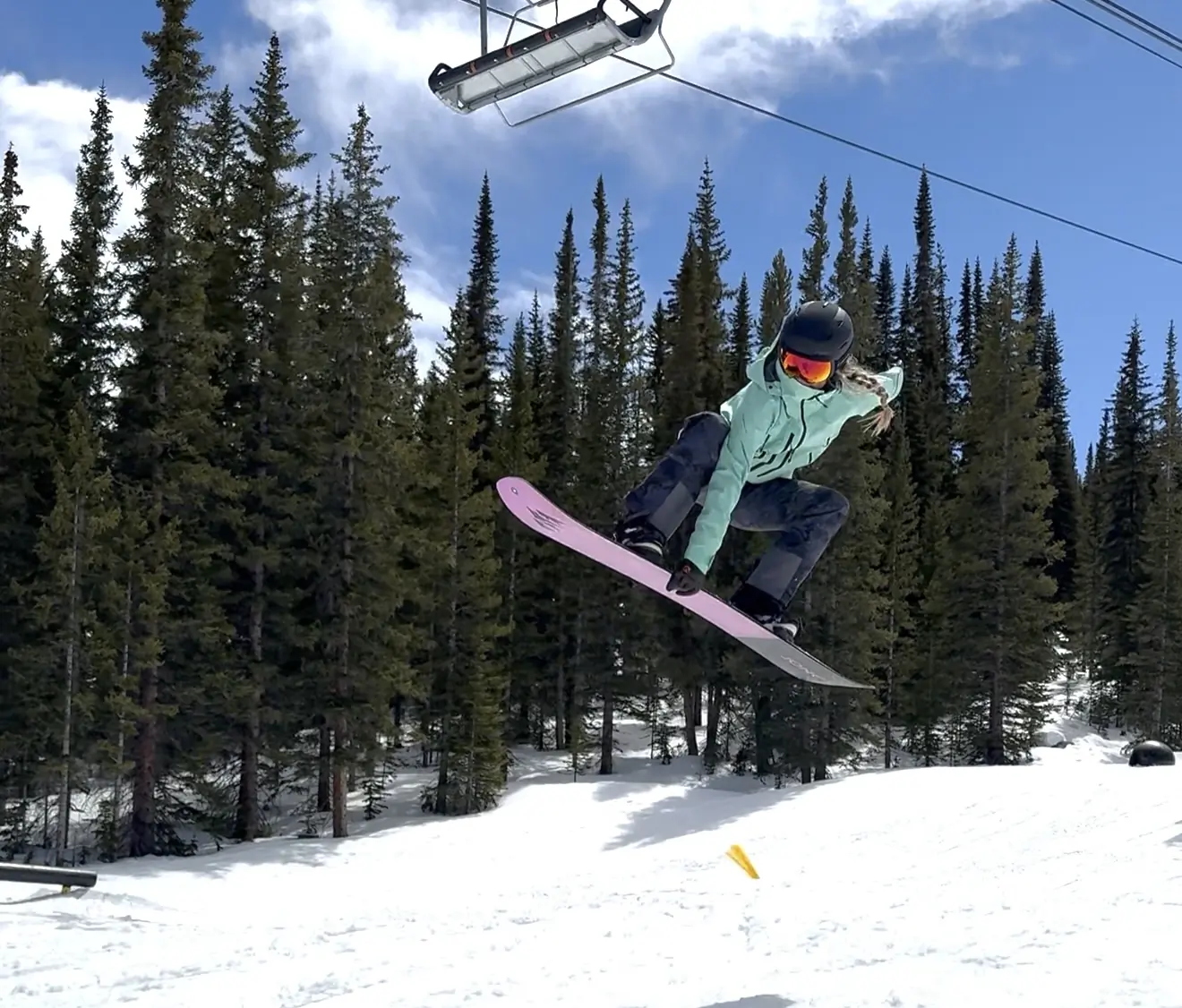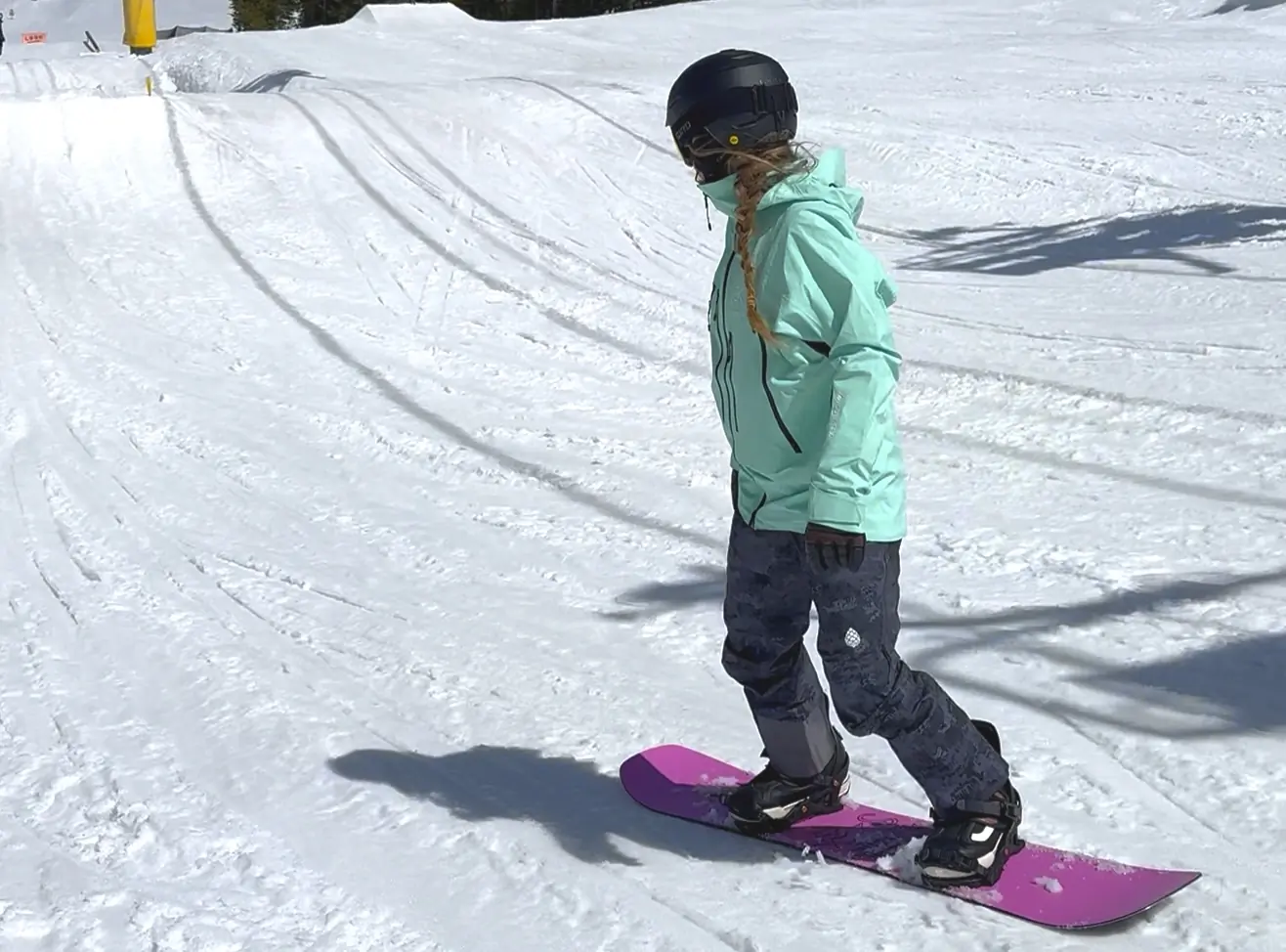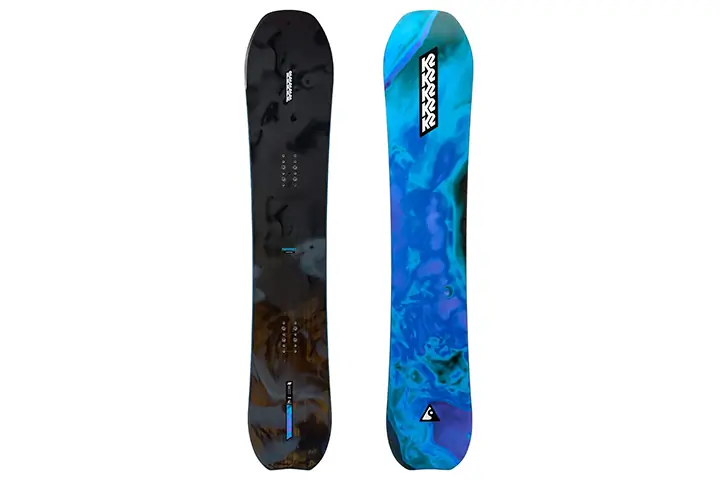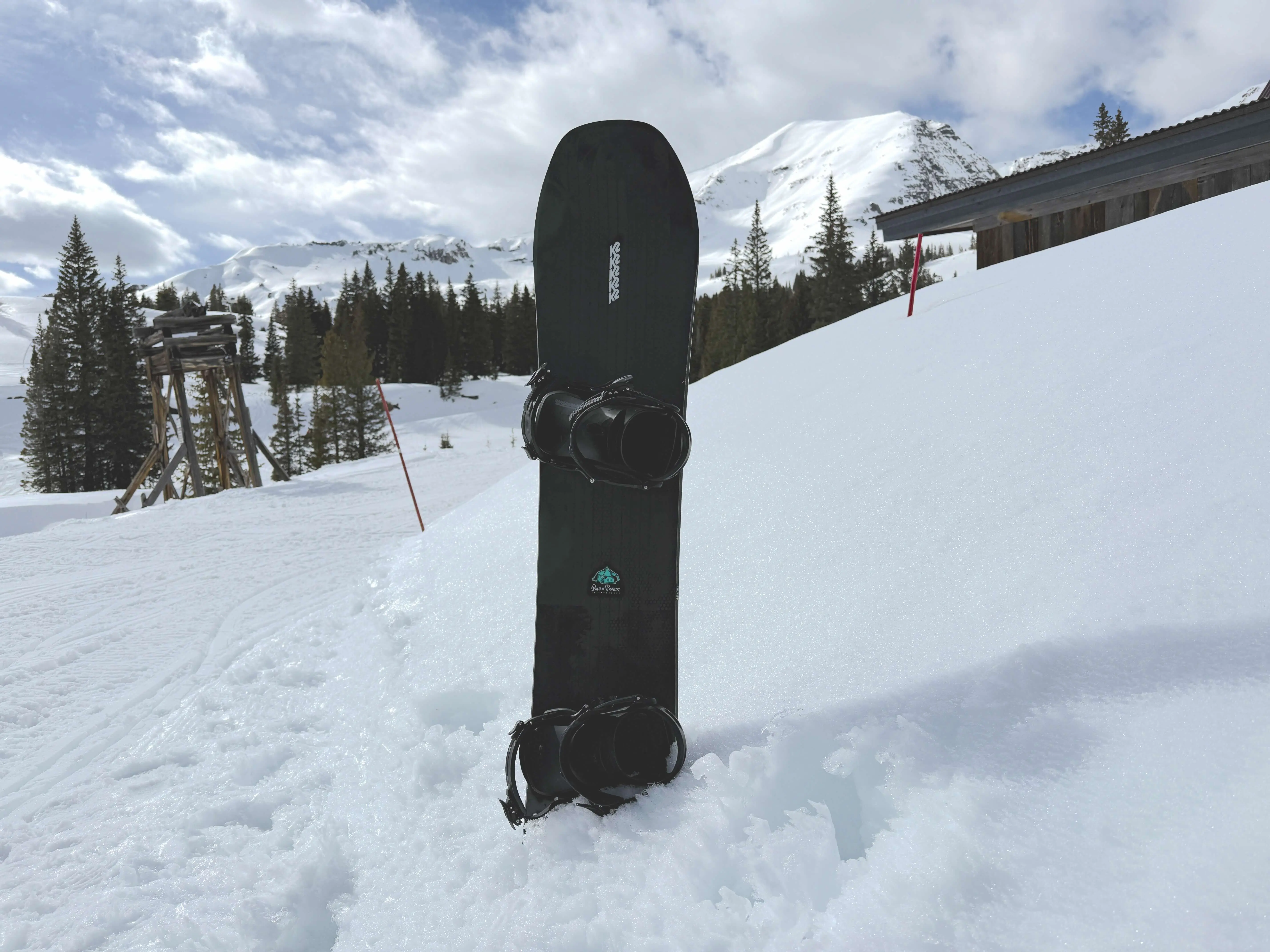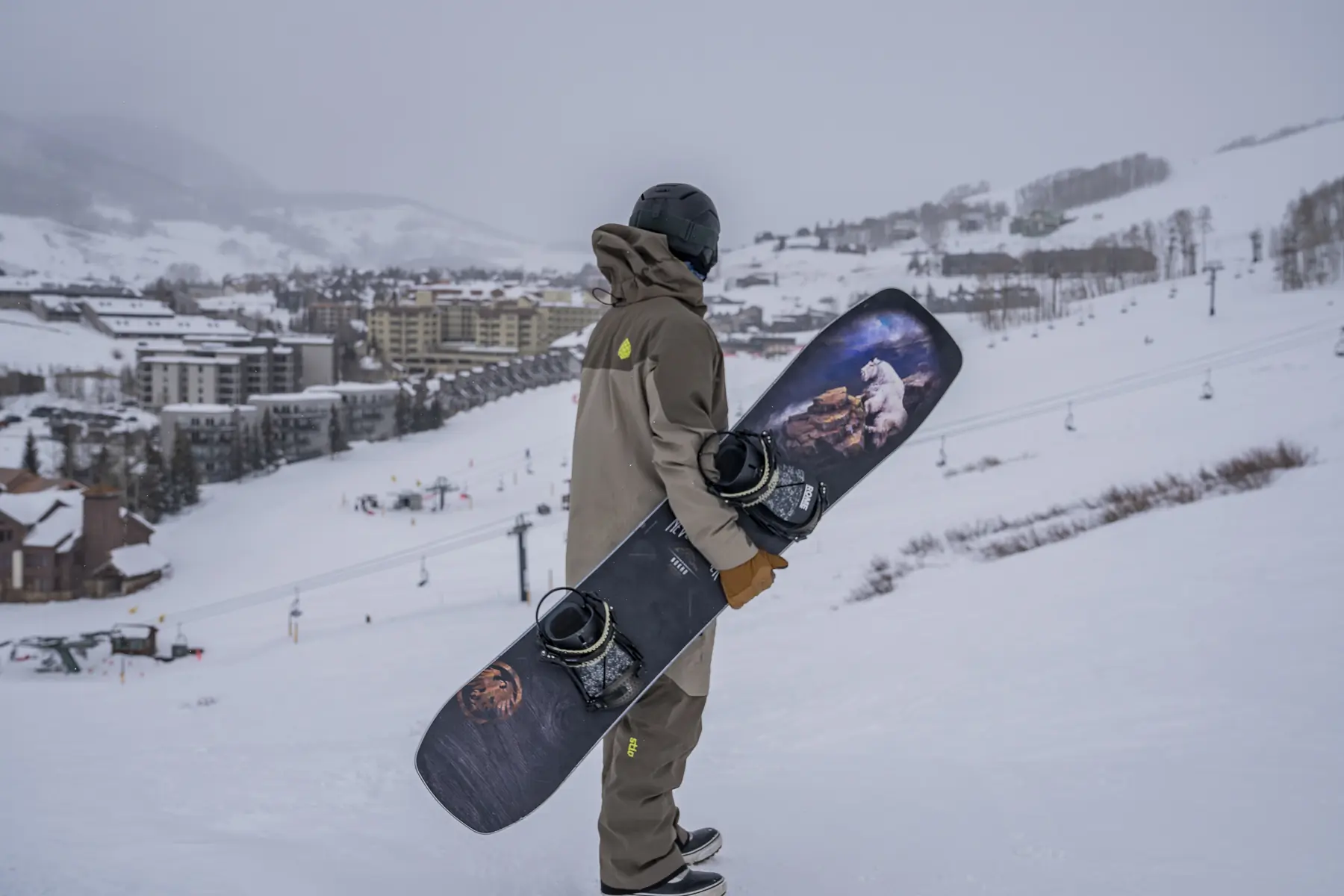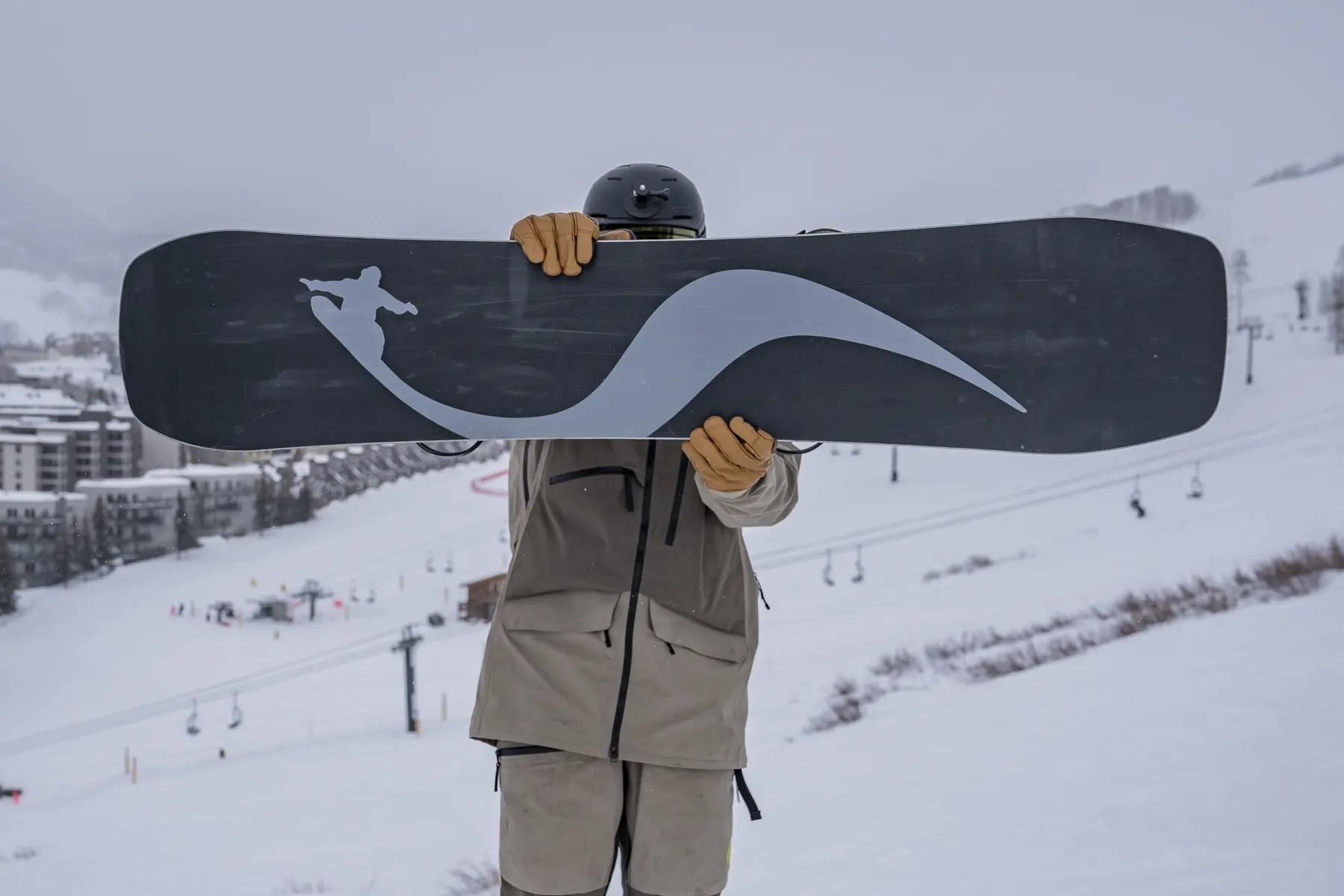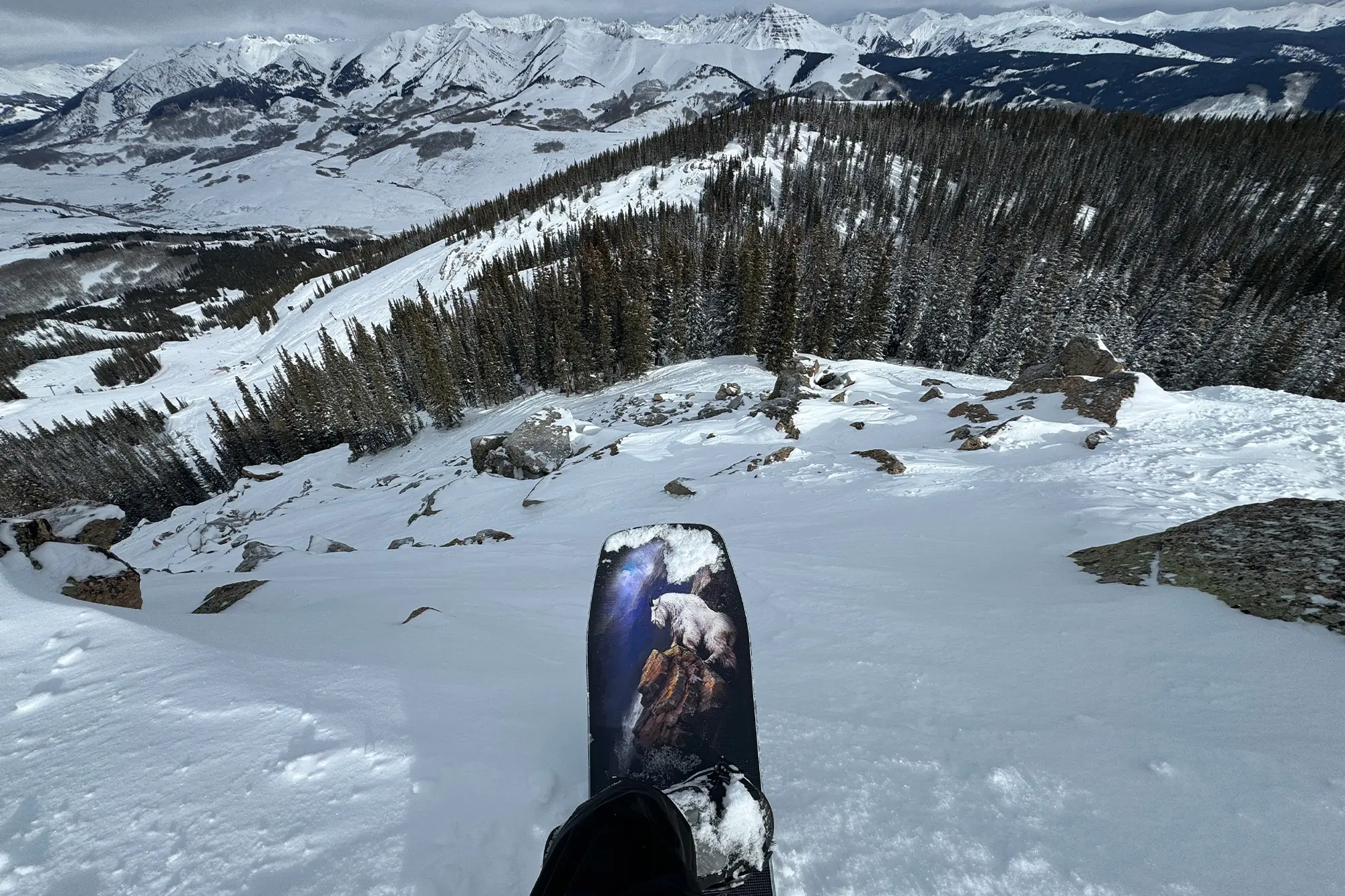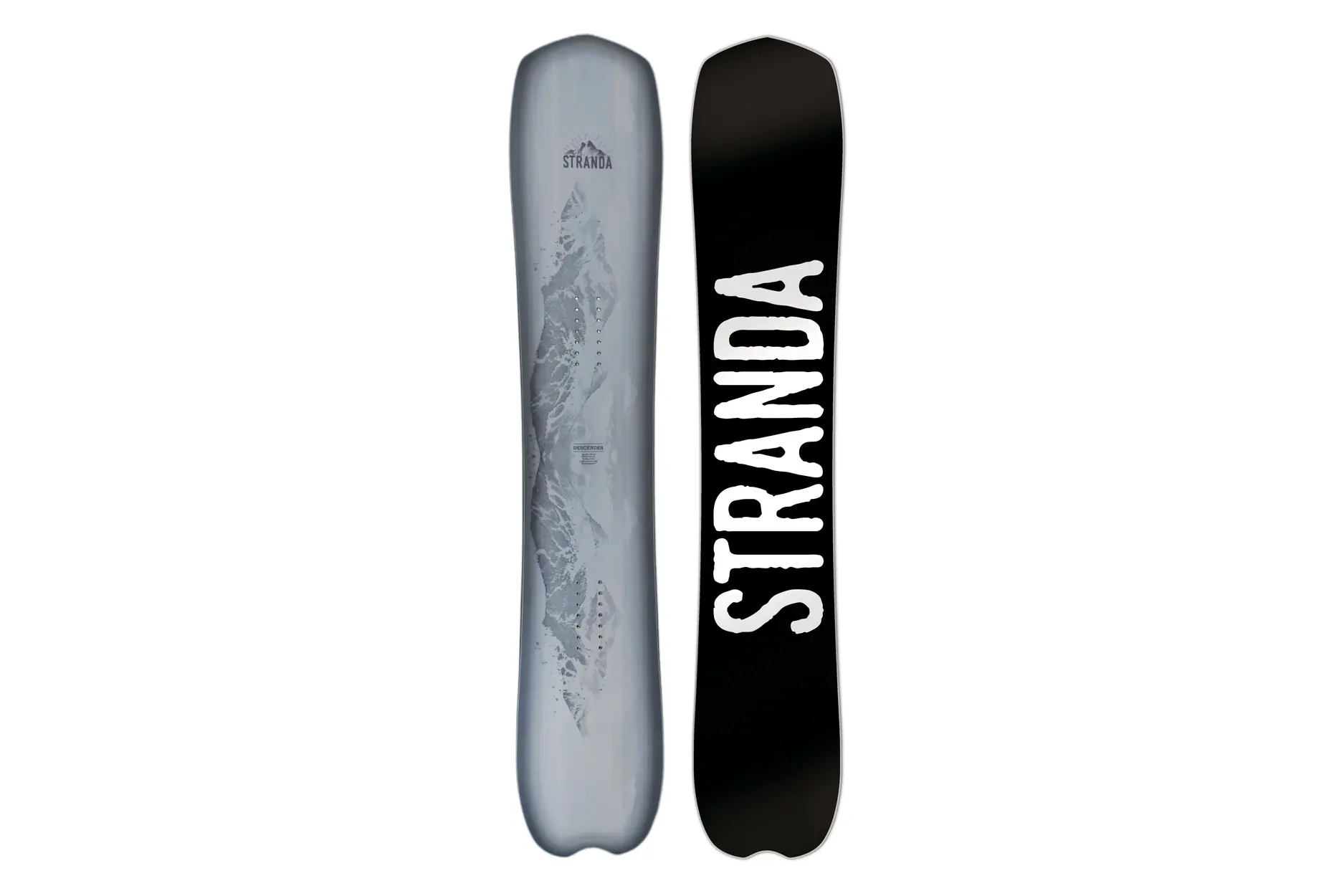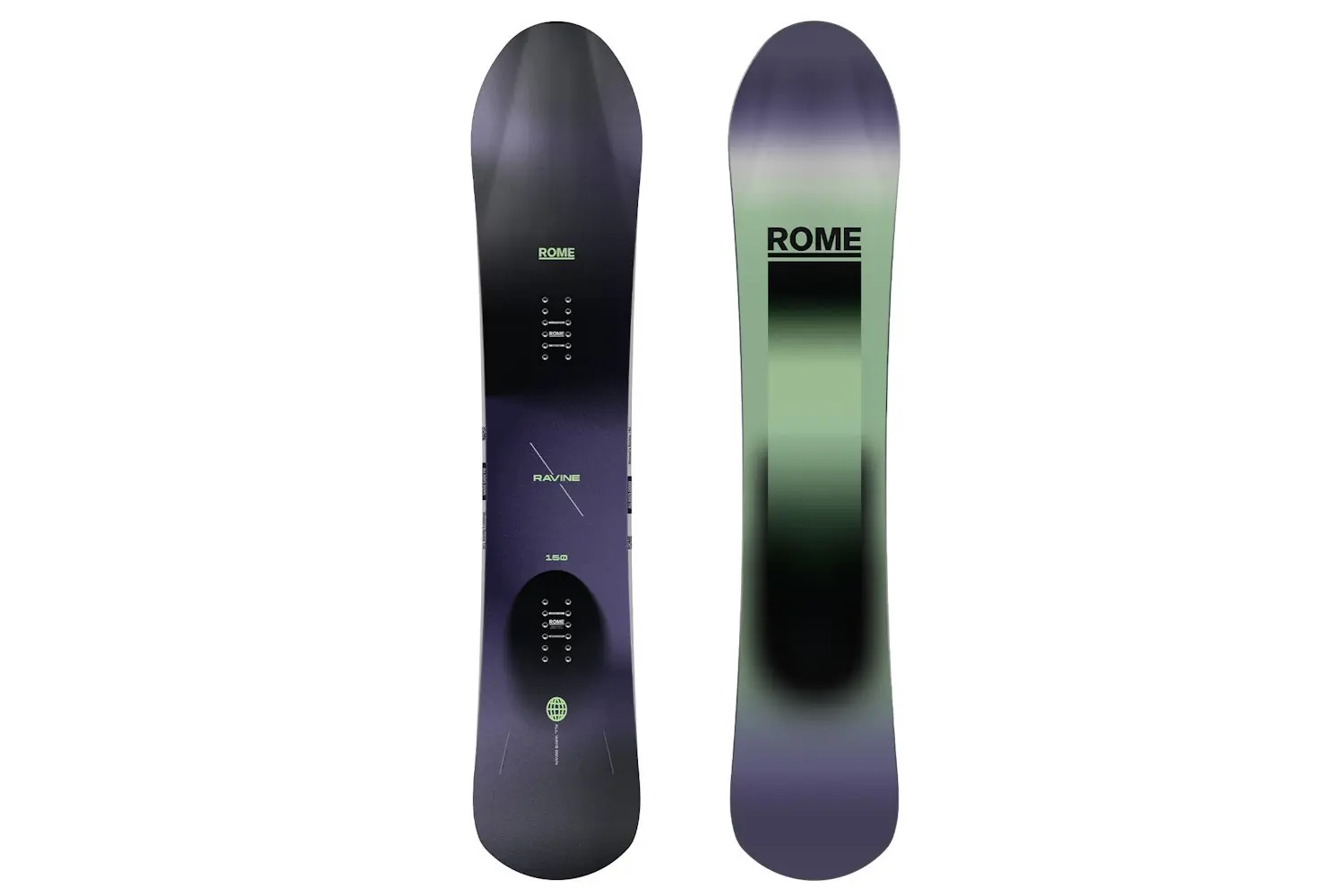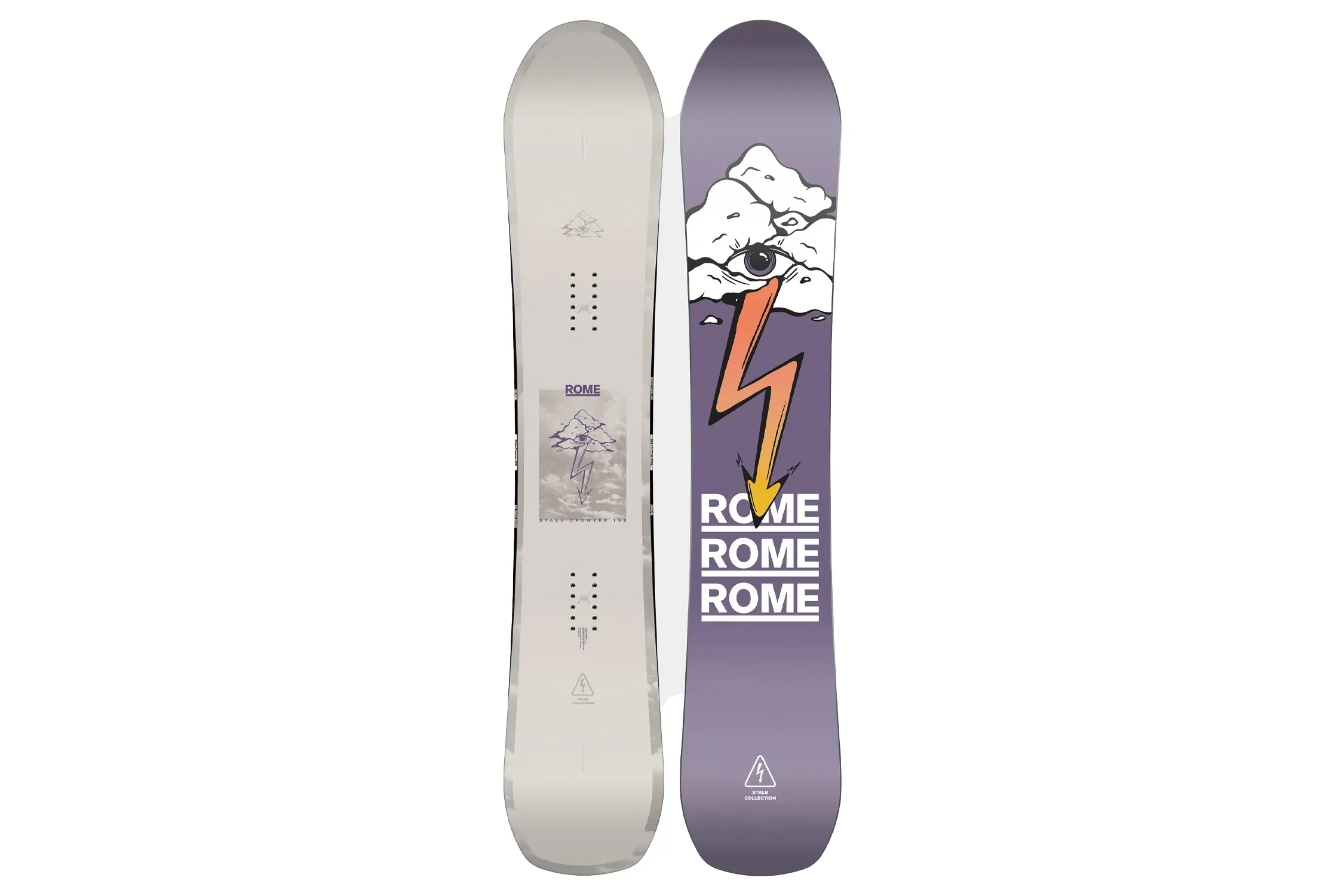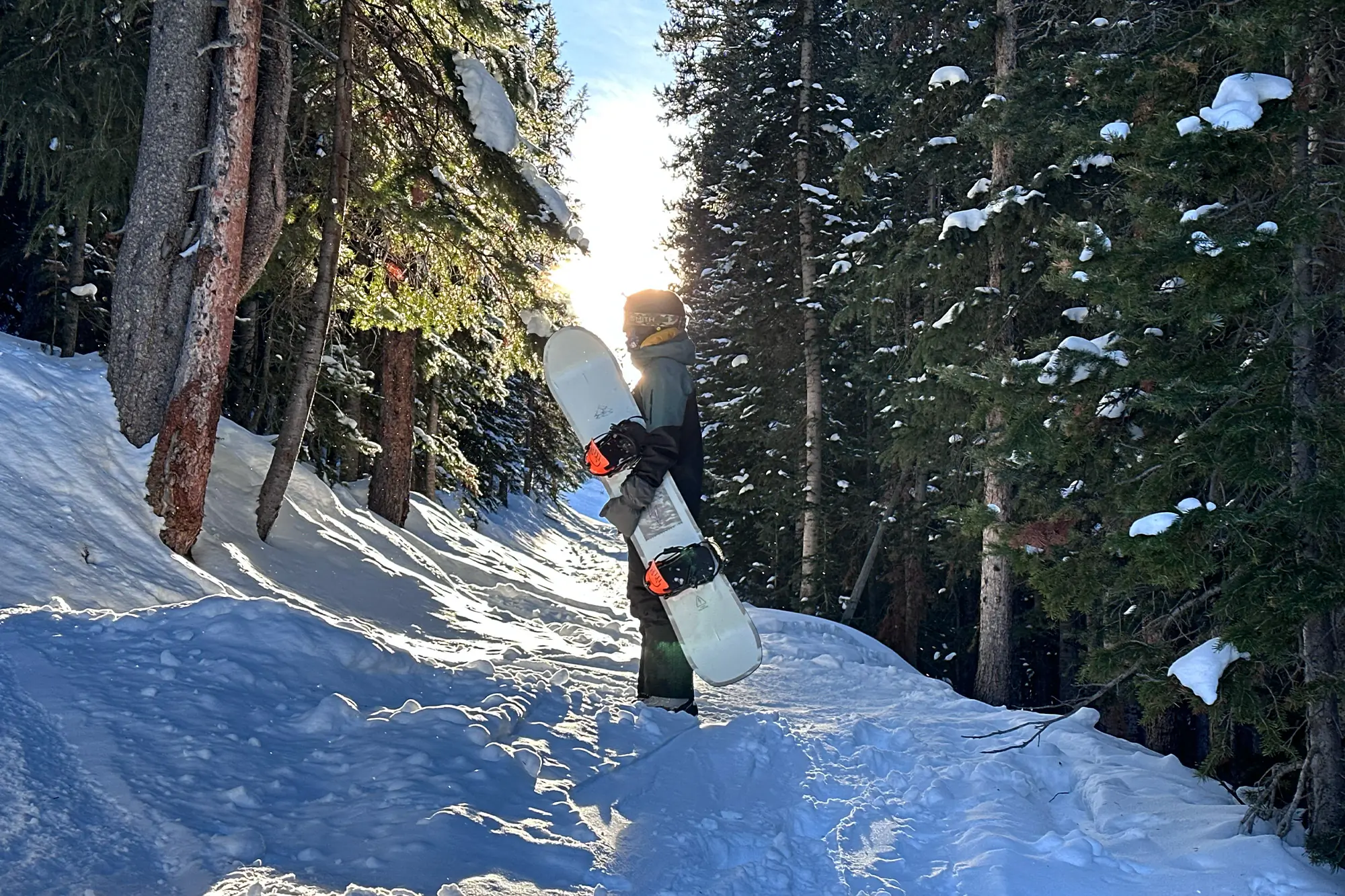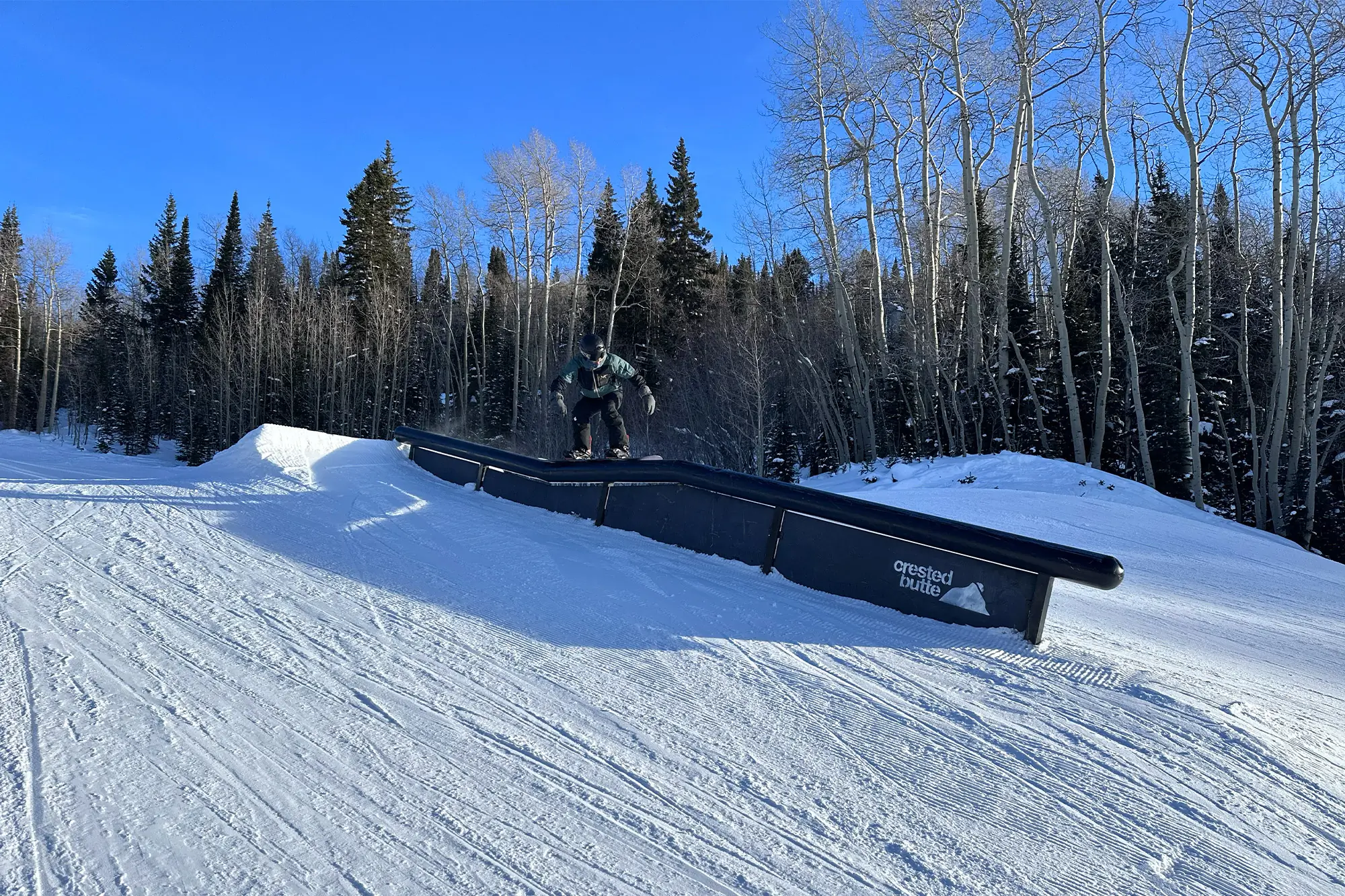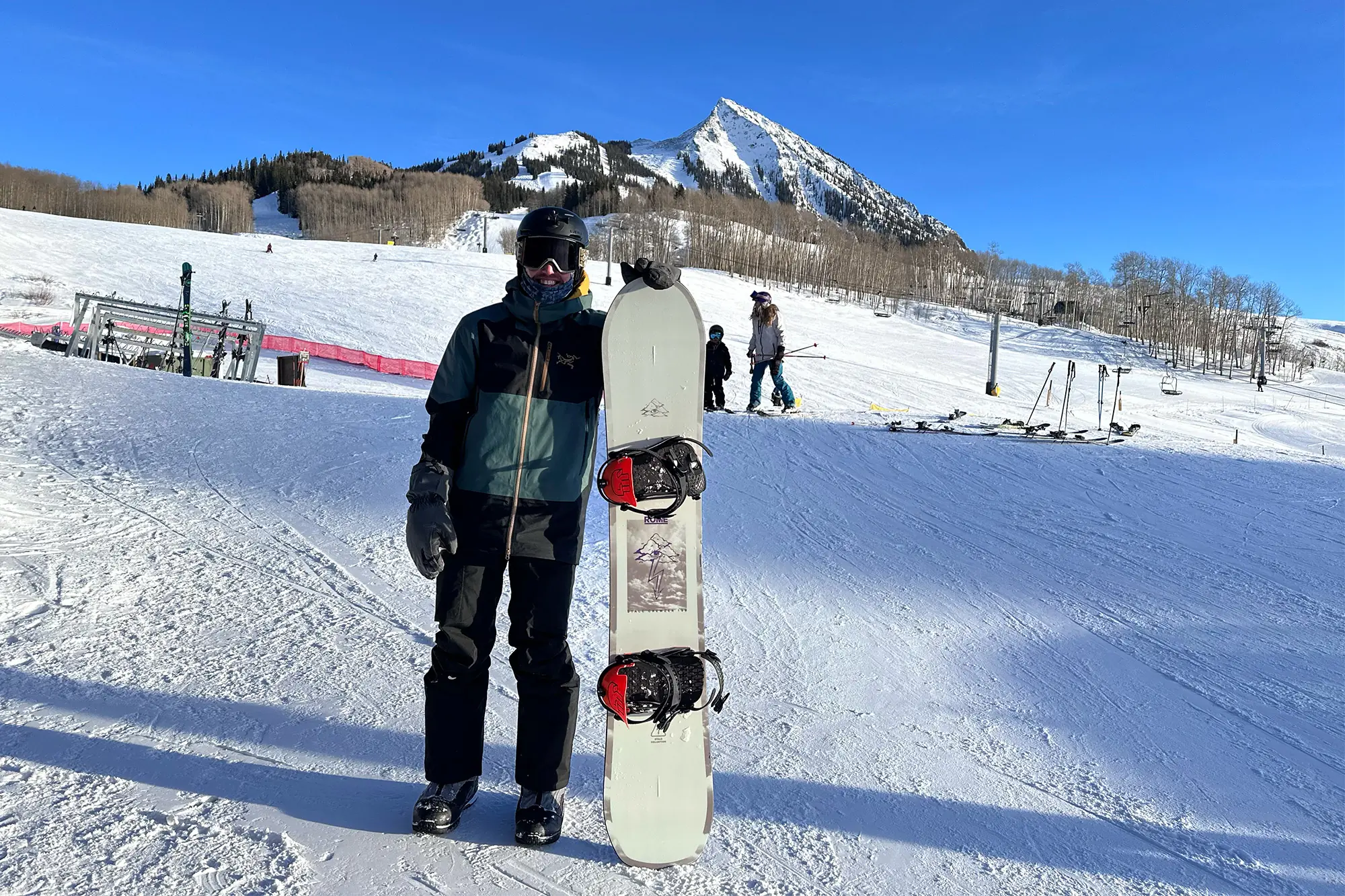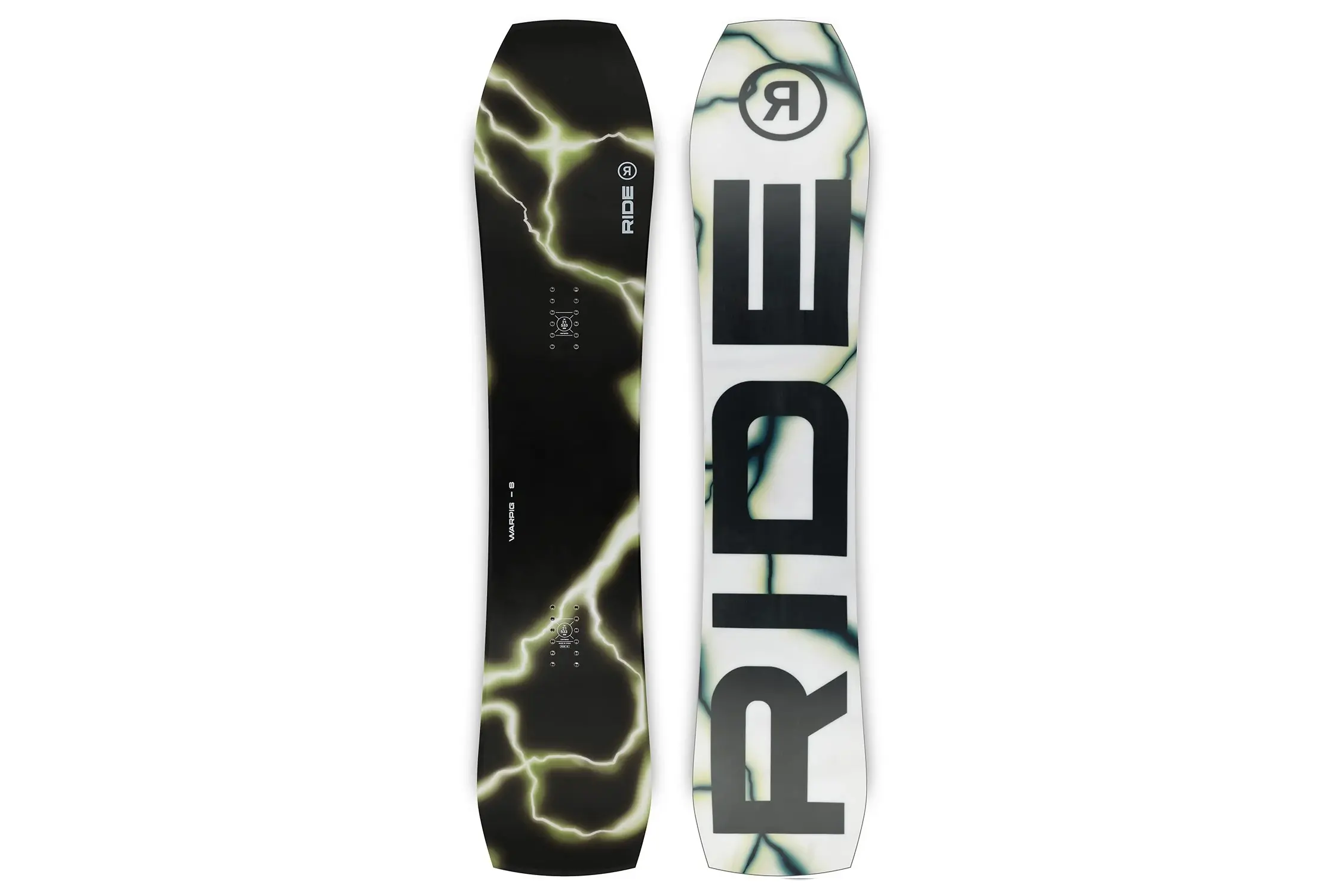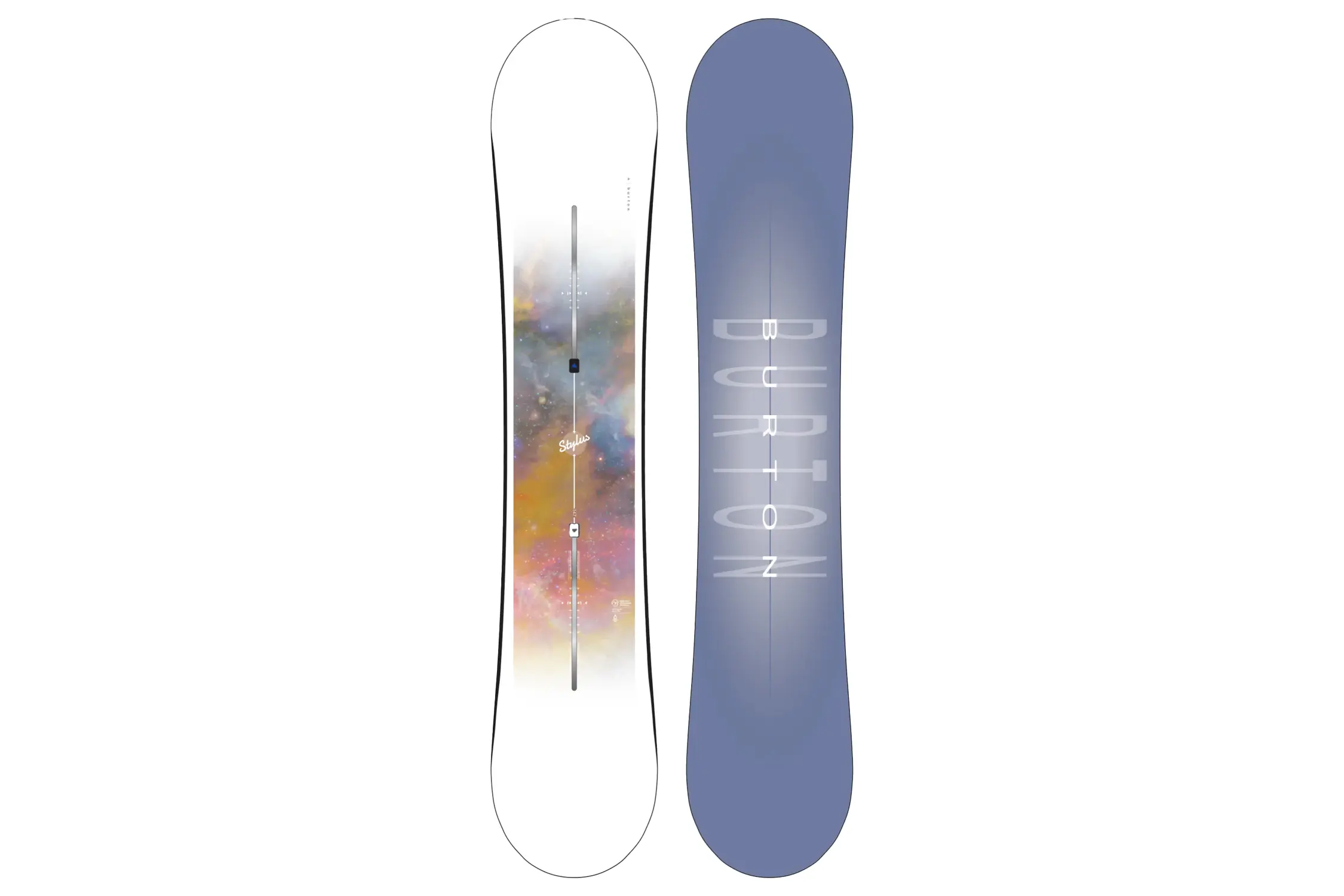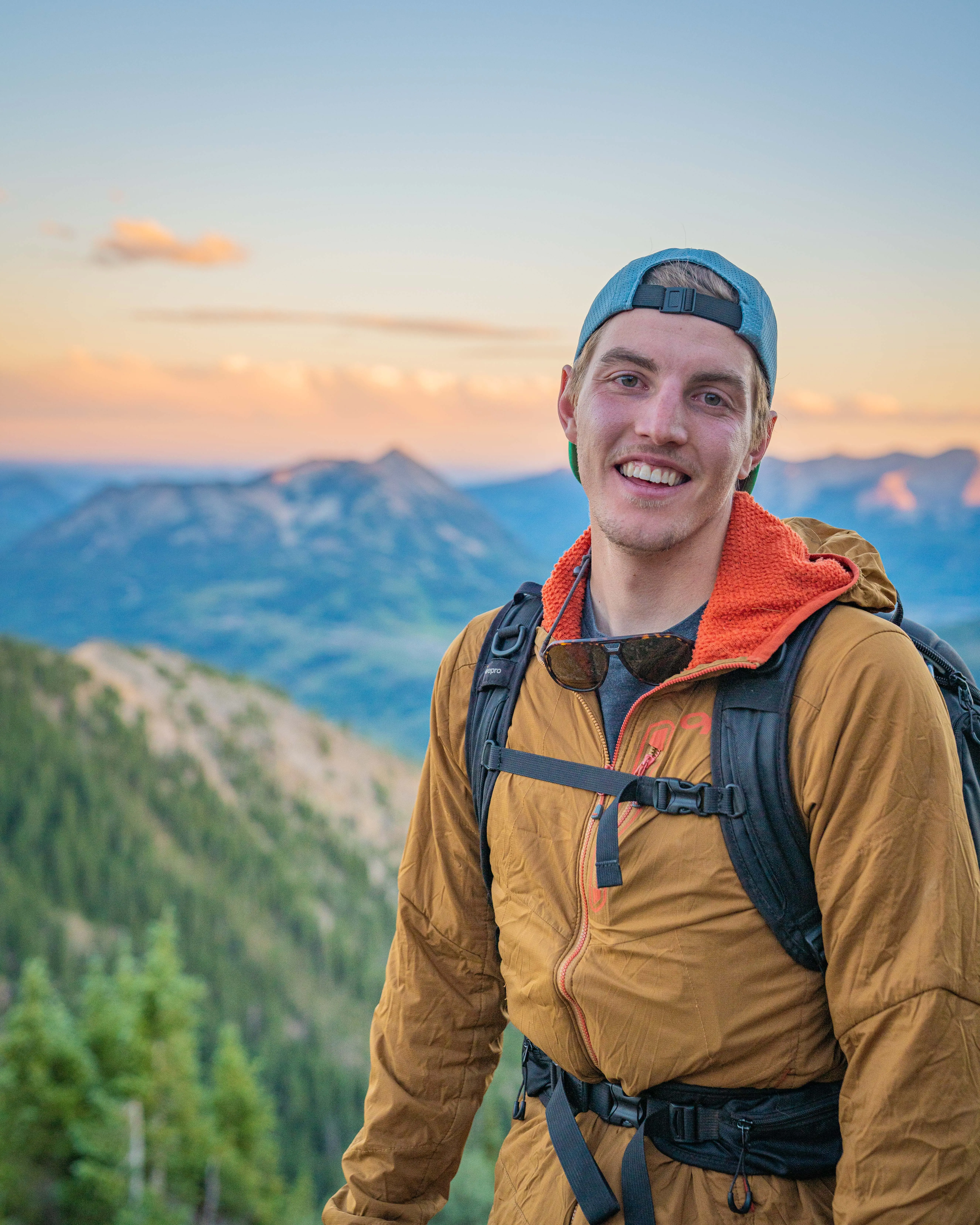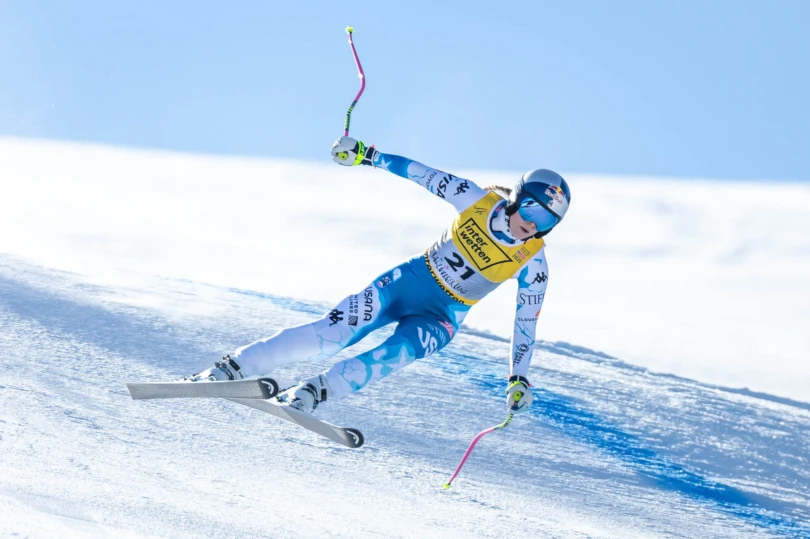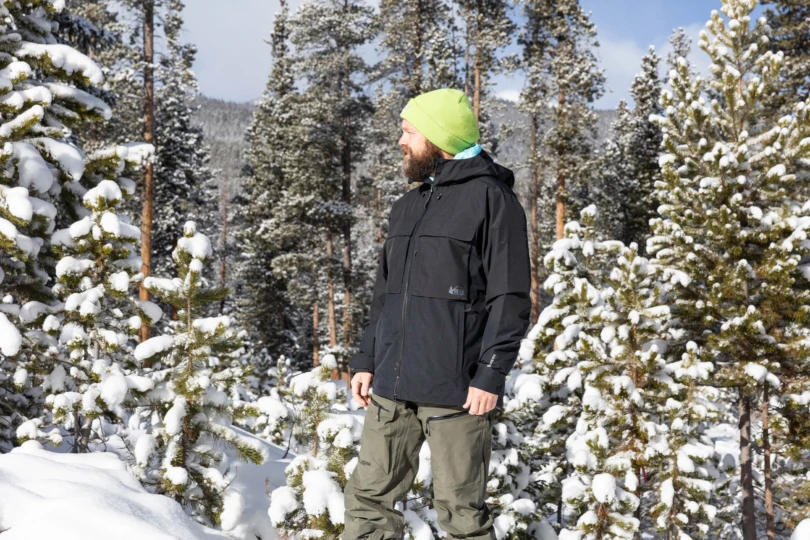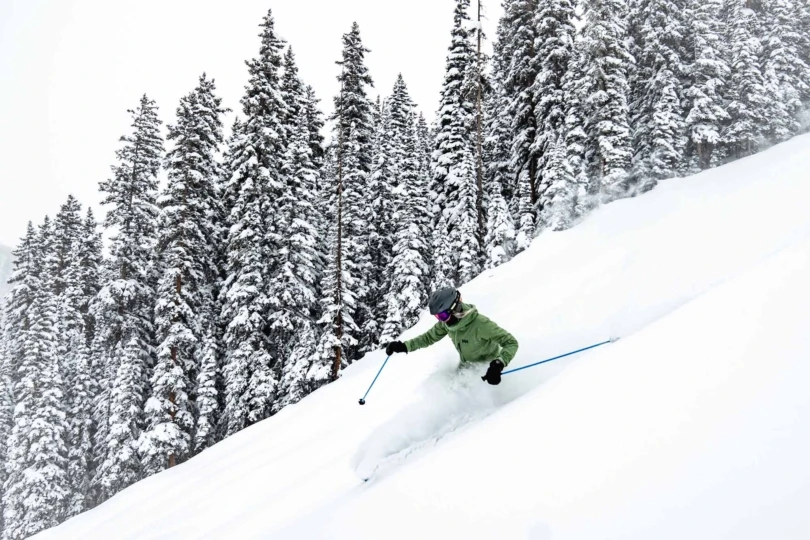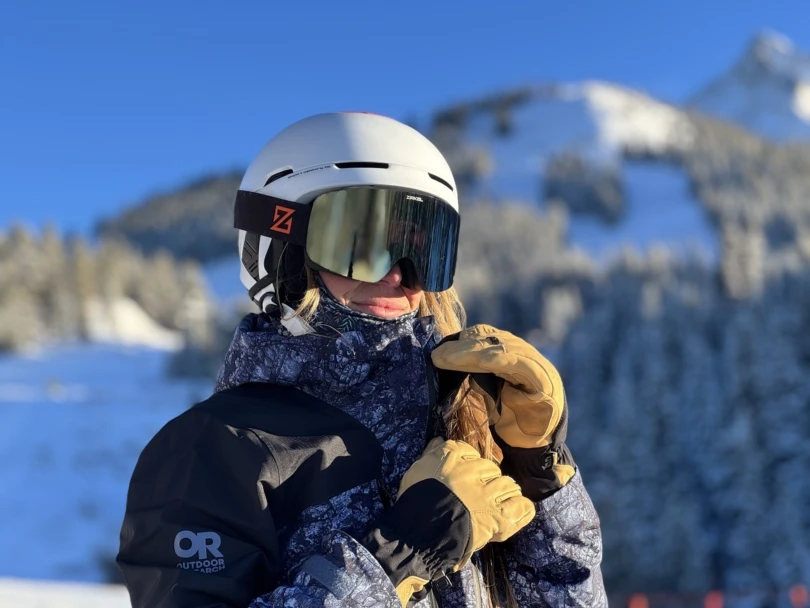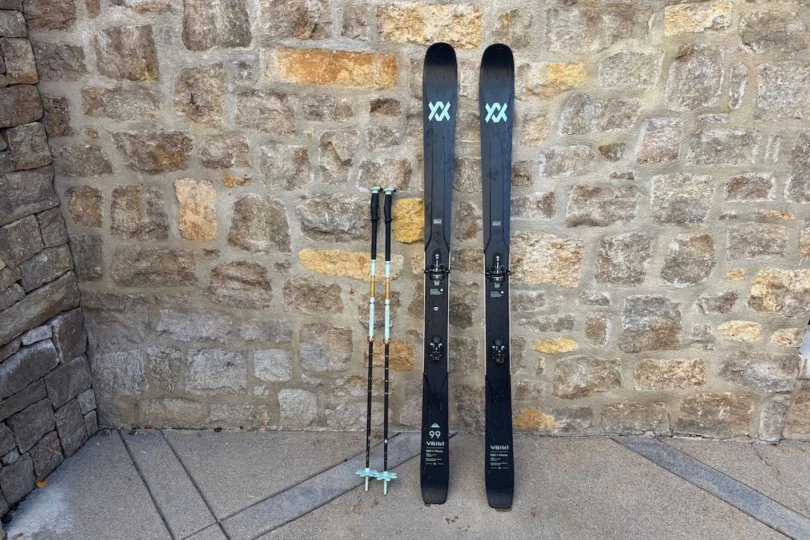All-mountain snowboards are like your favorite well-worn jeans: Comfortable and durable, you reach for them most days. From carving to lacing moguls and carefree powder floating, the snowboards on this list offer true quiver-of-one character. You’ll enjoy riding these boards across a variety of snow conditions and terrain at the local ski mountain. But each model also delivers a unique shape, profile, edge control, and flex. So there’s still some personality pairing to do, based on where and how you ride.
If you’re looking for a fun, edge-holding directional board that responds quickly in the glades, check out the Stranda Descender or Rome Ravine. For something that offers more flex and play, look into the Jones Rally Cat. Or, if you’d like the balance of a true twin, scope out the Never Summer Proto Type 3. For a more pliable twin, scope out the Burton Stylus Flat Top Snowboard. If you like power-packed laps with speed and steeps, go for a stiffer flex. Models on the soft end are more playful and agile.
Editor’s Note: We updated our All-Mountain Snowboards buyer’s guide on October 15, 2025, to include the field-tested and award-winning Yes Women’s Airmaster. We added an extended rating system that includes Shape, Flex, Profile, as well as Core and Construction. Swim through the details in our All-Mountain Snowboards Rating System.
The Best All-Mountain Snowboards of 2025-2026
Burton Family Tree Hometown Hero Camber Snowboard
-
Shape
9.0
-
Flex
9.0
-
Profile
8.0
-
Core and Construction
9.0
- Profile: Directional camber
- Shape: Freeride directional
- Flex: Twin
- Base: Sintered WFO
- Sizes (cm): 144, 148, 152, 156, 160, 156W, 160W, 165W
Pros
- Traditional camber feel for stability
- Tons of size options including wide widths
Cons
- Channel mounting system could be a drawback depending on your binding choice
- If you're looking for a rockered tail, look elsewhere
Jones Women’s Rally Cat
-
Shape
9.0
-
Flex
5.0
-
Profile
6.0
-
Core and Construction
8.5
- Profile: True camber (with a moderate 2.0-level 3D contour base)
- Shape: Directional twin
- Flex: 4/10 friendly flex
- Base: Sintered 8000 base
- Sizes (cm): 142, 145, 148, 151, 154
Pros
- Very playful feel
- Easy turn initiation and forgiving edges
- Nice pop for riding park and side hits
Cons
- Edge hold is not a match for carving in firm, icy conditions
- This isn't your hard-charging whip
K2 Passport
-
Shape
8.5
-
Flex
8.5
-
Profile
9.0
-
Core and Construction
9.0
- Profile: Hybrid camber between the feet, directional rocker on the ends (with more rocker in the nose than the tail)
- Shape: Directional
- Flex: 7/10
- Base: Sintered 4000
- Sizes (cm): 146, 149, 151, 154, 157, 159W, 160, 162W, 163, 151W, 154W, 157W
Pros
- Extremely stable board
- Handles power and speed through powder, cliff drops, or on groomers
- Edges aren't grabby
Cons
- Not your narrower choice if you prefer quicker edge transition
- Flexier boards are out there
Never Summer Nokhu 161 DF
-
Shape
7.9
-
Flex
6.0
-
Profile
9.0
-
Core and Construction
8.5
- Profile: Hybrid triple camber
- Shape: Directional
- Flex: 5 Medium
- Base: Durasurf XT Sintered 5501 base
- Sizes (cm): 152, 155, 158, 161, 161DF
Pros
- Wider than normal including Drag Free for large-footed riders
- R.I.P. Edge Hold technology provides excellent grip
- All-mountain shape and medium flex for diverse riding conditions
Cons
- Extra width can feel heavy
- Triple camber can feel hooky
Stranda Women’s Descender Snowboard
-
Shape
7.9
-
Flex
9.0
-
Profile
9.0
-
Core and Construction
9.0
- Profile: Parabolic camber (4mm) with slight rocker in the tip and tail
- Shape: Directional
- Flex: 7 (moderately stiff)
- Base: Sintered 4001 Durasurf
- Sizes (cm): 152, 148
Pros
- Traverses with a champion grip
- Easy to steer through tight terrain
- Stout yet poppy for variable or deep snow
Cons
- Directional shape doesn’t excel at riding switch
- Huge sweeping turns aren’t as fun with this shape
Rome Women’s Ravine
-
Shape
9.0
-
Flex
9.0
-
Profile
8.5
-
Core and Construction
9.0
- Profile: Rocker to camber with rise in the tip and tail
- Shape: Directional
- Flex: 7
- Base: Sinter Strong Base
- Sizes: 144, 147, 150, 153
Pros
- Very stable
- Maneuverable
- Carries speed well
Cons
- Not top choice for switch
- Softer boards are out there if that's the preference
Never Summer Women’s Proto Type 3 Snowboard
-
Shape
9.0
-
Flex
9.0
-
Profile
9.0
-
Core and Construction
8.5
- Profile: Triple Camber Hybrid
- Shape: True twin
- Flex: 6 out of 10
- Base: Durasurf XT Sintered 5501 Base
- Sizes (cm): 139, 142, 145, 148, 151
Pros
- Balanced board with true twin design
- R.I.P. Edge Hold Technology adds waves to base for enhanced edge control
- Innovative stitched carbon allows for meticulous carbon layup
Cons
- If you want a more freestyle park board, check out other options
Other Whips We Love To Shred
-
Shape
8.0
-
Flex
6.0
-
Profile
8.0
-
Core and Construction
8.0
- Profile: Cambered underfoot with rocker between the feet
- Shape: Directional twin
- Flex: 3 (soft)
- Base: Sintered
- Sizes: 150, 154, 154W, 156, 158. 158W, 162, 162W, 166W 158W, 162, 162W, 166W
Pros
- Fun and forgiving ride
- High-quality edge and base materials
Cons
- Not ideal for aggressive carving or riding at high speed
-
Shape
7.0
-
Flex
6.0
-
Profile
8.0
-
Core and Construction
8.0
- Profile: Camber between the feet, rocker in the tip and tail
- Shape: Twin
- Flex: 5 (medium)
- Base: Sintered
- Sizes: 148, 150, 152, 153W, 154, 155W, 156, 157W, 158, 159W, 160, 161W, 162, 163W
Pros
- Versatile
- Stable
- Lots of pop
Cons
- Aggressive handling takes some getting used to
-
Shape
8.0
-
Flex
8.0
-
Profile
8.0
-
Core and Construction
8.0
- Profile: C2x profile is rocker between feet, camber beneath feet, rocker on ends
- Shape: Asymmetric
- Flex: 5 (medium)
- Base: Sintered
- Sizes (cm): 139.5, 142.5, 145.5, 148.5, 153.5
Pros
- Magne-Traction edge hold
- Lightweight core
- Well-rounded
Cons
- Not the stiffest for aggressive carving
-
Shape
7.0
-
Flex
7.0
-
Profile
7.0
-
Core and Construction
8.5
- Profile: High camber with Y3D raised edges at the tip and tail
- Shape: Directional twin
- Flex: 6 (flexier)
- Base: Extruded
- Sizes (cm): 146, 149, 152
Pros
- Super playful all-mountain board
- Forgiving edges
- Nice moderate flex
- Wide, stable base
Cons
- Not an ideal tool for steep, icy terrain
- Choose a different board for deep, huge freeride carves
- Stiffer boards are better for speed demons
-
Shape
7.9
-
Flex
8.9
-
Profile
9.0
-
Core and Construction
8.0
- Profile: Fusion Camber / Rocker – Camber – Rocker
- Shape: Directional twin
- Flex: 6 (Medium hard)
- Base: Sintered
- Sizes (cm): 152, 155, 158, 159w, 161, 162w
Pros
- Excels in the park and on side hits
- Stable in the steeps
- Impact plates for additional impact absorption
Cons
- Not the best in powder
-
Shape
8.9
-
Flex
5.5
-
Profile
7.0
-
Core and Construction
8.0
- Profile: Traditional camber
- Shape: Directional twin
- Flex: 4 (medium soft)
- Base: Sintered
- Sizes: 153, 156, 159, 160MW, 161W, 162, 165W
Pros
- Great value
- High-quality construction
Cons
- Chatters at high speeds
-
Shape
6.0
-
Flex
6.0
-
Profile
8.5
-
Core and Construction
8.5
- Profile: Directional rocker
- Shape: Tapered and directional
- Flex: 4 (medium soft)
- Base: Sintered
- Sizes: 142, 148, 151, 154, 158
Pros
- Versatile
- Playful
- Good value
Cons
- Not the best for long radius turns at high speeds
-
Shape
6.0
-
Flex
7.5
-
Profile
8.0
-
Core and Construction
8.9
- Profile: Rocker-camber blend
- Shape: Directional twin
- Flex: 7 (medium-stiff)
- Base: Sintered
- Sizes (cm): 145, 149, 153, 156
Pros
- Queen for big turns
- Handles high speeds
Cons
- Not your jib stick or pipe vehicle
-
Shape
7.5
-
Flex
7.5
-
Profile
8.0
-
Core and Construction
9.0
- Profile: Camber under foot, rocker through the tip and tail
- Shape: Directional twin
- Flex: 7 (medium stiff)
- Base: Top-notch sintered base
- Sizes: 151, 154, 156W, 157, 159W, 160, 162W, 163, 165W, 168W
Pros
- Versatile
- Damp and smooth ride
- Very durable base
Cons
- Not ideal for beginners
-
Shape
8.0
-
Flex
4.0
-
Profile
5.0
-
Core and Construction
7.0
- Profile: Camber to rocker on the ends
- Shape: Twin
- Flex: 2 (soft)
- Base: Extruded
- Sizes (cm): 138, 142, 147, 152
Pros
- Easy to control
- Slow, non-grabby edge-to-edge transfer alleviates quick catches
Cons
- Does not wrestle steep, rough, challenging terrain or love higher speeds
- Channel board mount is directly compatible with Burton bindings. Otherwise, you’ll need specific additional hardware to connect bindings to the board

All-Mountain Snowboard Comparison Chart
Scroll right to view all of the columns: Price, Profile, Shape, Flex, Sizes.
| All-Mountain Snowboards | Price | Profile | Shape | Flex | Sizes |
| Burton Family Tree Hometown Hero Camber | $680 | Directional camber | Freeride directional | Twin | 144, 148, 152, 156, 160, 156W, 160W, 165W |
| Jones Women’s Rally Cat | $480 | True camber (with a moderate 2.0-level 3D contour base) | Directional twin | 4/10 friendly flex | 142, 145, 148, 151, 154 |
| Stranda Descender | $749 | Camber, rocker | Directional | 7 (medium) | 152, 148 |
| Rome Ravine | $530 | Rocker to camber | Directional | 7 | 144, 147, 150, 153 |
| Never Summer Nokhu 161 DF | $690 | Hybrid triple camber | Directional | 5 (medium) | 152, 155, 158, 161, 161DF |
| Never Summer Women’s Proto Type 3 | $500 | Triple Camber Hybrid | True twin | 6 out of 10 | 139, 142, 145, 148, 151 |
| K2 Passport | $600 | Hybrid camber between the feet, directional rocker on the ends (with more rocker in the nose than the tail) | Directional | 7/10 | 146, 149, 151, 154, 157, 159W, 160, 162W, 163, 151W, 154W, 157W |
| Burton Custom Flying V | $680 | Camber, rocker | Directional twin | 3 (soft) | 150, 154, 154W, 156, 158. 158W, 162, 162W, 166W 158W, 162, 162W, 166W |
| CAPiTA Defenders of Awesome | $580 | Camber, rocker | Twin | 5 (medium) | 148, 150, 152, 153W, 154, 155W, 156, 157W, 158, 159W, 160, 161W, 162, 163W |
| GNU Ladies Choice | $630 | C2x profile | Asymmetric | 5 (medium) | 139.5, 142.5, 145.5, 148.5, 153.5 |
| Yes Snowboards Airmaster Woman | $530 | High camber with Y3D raised edges at the tip and tail | Directional twin | 6 (flexier) | 146, 149, 152 |
| Rome Stale Crewzer | $600 | Fusion camber, rocker – camber – rocker | Directional twin | 6 (medium-hard) | 152, 155, 158, 159w, 161, 162W |
| Arbor Element Camber | $550 | Camber | Directional twin | 4 (medium soft) | 153, 156, 159, 160MW, 161W, 162, 165W |
| Ride Warpig | $600 | Directional rocker | Tapered and directional | 4 (medium soft) | 142, 148, 151, 154, 158 |
| Rossignol After Hours | $650 | Rocker-camber blend | Directional twin | 7 (medium-stiff) | 145, 149, 153, 156 |
| Jones Mountain Twin | $580 | Camber, rocker | Directional twin | 7 (medium stiff) | 151, 154, 156W, 157, 159W, 160, 162W, 163, 165W, 168W |
| Burton Stylus Flat Top | $400 | Camber to rocker | Twin | 2 (soft) | 138, 142, 147, 152 |


How We Tested All-Mountain Snowboards
Our snowboard crew of GearJunkie product testers and writers includes a range of expert snowboarders.
Our Expert Testers
Leading the on-snow tests, SnowSports Senior Editor Morgan Tilton has been snowboarding since 2002, when she switched from two planks to one. She started sliding on snow at age 4 on the steeps of Telluride Ski Resort in her hometown. Over the years, she’s competed in Slopestyle comps, backcountry tours, pow surfs, snowmobiles, and still pulls on skis. While she coordinates the testers, she gets out in the field, too.
In the 2024-2025 season, she tested all-mountain snowboards across North America at Telluride Ski Resort, Silverton Mountain Ski Area, Crested Butte Mountain Resort, Big Sky Resort, and park days at Copper Mountain Ski Resort. She rode in British Columbia at Whitewater Ski Resort and Red Mountain. She also tested solids while snowcat skiing with Irwin Guides and at Baldface Valhalla. The snowboards covered nearly 195,000 vertical feet, 690 miles, and 126 hours across 34 days. In early 2024, Tilton tested all-mountain snowboards for 135 hours across 38 days. She tested all-mountain snowboards for 104 hours across 34 days in 2023.
Contributing photographer and tester Eric Phillips is a formerly certified Level II PSIA-AASI instructor and big mountain pow surfer when he’s not at the resort or on splitboard tours.
Other contributors include Wyoming-based Austin Beck-Doss and Crested Butte-based shredder Will Martinez.




Our Testing Grounds
We’ve tested snowboards in a range of conditions, from Vancouver Island to the Colorado Rockies and high-alpine environments. Our snowboards have carved steep, groomed, icy terrain, wiggled through tight trees, and floated through deep powder.
The GearJunkie team meets for on-snow test weeks to grind out turns and swap notes, including two previous gatherings at Crested Butte Mountain Resort, which is known for its expert terrain.
Our Testing Process
While testing all-mountain snowboards, we consider versatility, stability, flex, stiffness, carveability, edge hold, and overall value. We also take into consideration the most novel, style-specific, popular, highly rated, and legacy products across a range of price points.
Our All-Mountain Snowboards Rating System
We score each all-mountain snowboard on a 1–10 scale for Shape, Flex, Profile, as well as Core and Construction.
Shape: Directional twin is the most common all-mountain board shape, followed closely by a true twin. The shape influences how the board feels! There are plenty of playful shapes for pow riding but, for most days and conditions, we tend to need a more traditional or directional shape for riding everywhere on the mountain.
Flex: The sweet spot for flex is 5-8 for variable conditions. A softer flex allows easier turns and a more playful feel under boot. A stiffer flex prevents fatigue and helps you charge through chunky snow or hold an edge in tough terrain. It provides stability.
Profile: Most boards have a unique variation of a hybrid profile, blending camber and rocker (reverse camber). This allows a happy medium between grip, pop, and float, as well as edge hold and stability.
Core and Construction: Various materials influence how the board feels. A wood core — often poplar, paulownia, or bamboo — offers strength and responsiveness. Adding carbon or basalt stringers increases reactivity, pop, and dampening without a weight penalty.
The Overall Rating is based on contextual, editorial judgment, and the complex user experience across various scenarios and conditions.




The Best All-Mountain Snowboards: A Buyer’s Guide
What is an All-Mountain Snowboard?
All-mountain snowboards are designed to handle various riding styles and types of terrain. A true all-mountain snowboard will perform relatively well on groomers, powder, hardpack, and everything in between.
If you’re the kind of rider who likes to mix it up and hit the park on one run and a powder stash on the next, an all-mountain snowboard is the right choice for you.
All-mountain snowboards are also well-known for their value. Instead of owning multiple specialist boards for different styles and conditions, a single all-mountain board can be your answer to everything — kind of like a Swiss Army knife.
Because these boards aren’t specialists, they generally make some compromises in order to work well all over the mountain. For example, a good all-mountain board should ride well in the powder, but it probably won’t perform quite as well as an aggressively directional powder surfing specialist.


Types of All-Mountain Snowboards
On this list, we’ve included many types of all-mountain snowboards. Each leans toward a certain style of riding. For example, our pick for the best powder-leaning all-mountain snowboard will certainly rip all over the mountain, but it will truly shine when riding pow. We’ve also included freestyle-leaning all-mountain snowboards and hard-carving all-mountain snowboards.
Powder-Leaning All-Mountain
Powder-leaning all-mountain snowboards are the perfect tool for the deepest of days. Generally, snowboards in this category have a directional shape with a large, wide nose and a tapered-down tail. This is the ideal shape for maximum float in untouched snow.
Additionally, powder-leaning all-mountain snowboards usually have a rockered or hybrid rockered profile, which creates lift and keeps you happily afloat. On this list, the Ride Warpig and the Jones Women’s Flagship are our favorite boards for riding powder.


Freestyle-Leaning All-Mountain
Freestyle-leaning all-mountain snowboards will display their full potential in the terrain park. Designed with jumps, rails, and side hits in mind, these boards feature ample pop, skate-like snap, and stability to stick the landing in style.
Most freestyle-leaning snowboards have a true twin or slightly directional twin shape. Boards in this category tend to have relatively flat or mildly rockered profiles, though there are some exceptions to this. On this list, our favorite freestyle-leaning boards are the Never Summer Infinity Snowboard and the YES. Typo.




Snowboard Profile & Shape
A snowboard profile is the silhouette of a snowboard when viewed from the side if you were to set the board flat on a table and look at it lengthwise.
The profile is technically separate from the snowboard’s overall shape, but it’s also an ingredient that influences the shape category a board lands in — like adding cilantro or jalapeño to guacamole.
Imagine looking straight down at a snowboard that’s flat on the ground. The board’s shape is literally its outline, which is defined by the width from any side-to-side point, as well as the frame of the nose and tail.
Together, the board’s shape and profile create a unique feel underfoot. The various shape categories for snowboards listed below (directional, true twin, directional twin, asymmetrical, asymmetrical twin) are based on the profile and shape as well as the core materials and the flex they create.




Types of Snowboard Profiles
Camber
This is the most traditional, old-school snowboard profile. With a cambered design, the center rises, and the far ends of the board meet the ground where the nose and tail upturn. The sides curve upward a bit, too.
Boards with camber offer excellent edge control and a precise, aggressive, stable ride.
Rocker
Rocker is the opposite of camber, and it’s often called reverse camber. Lib Tech started this revolution with the original Skate Banana rocker board, so some folks refer to this feature as “banana technology.” It is a banana shape!
Instead of camber, the belly of the board presses into the ground, so it’s a convex or U-shape. The result is a superb float in powder, a more forgiving edge-to-edge experience, and a more surf-life experience in carves.
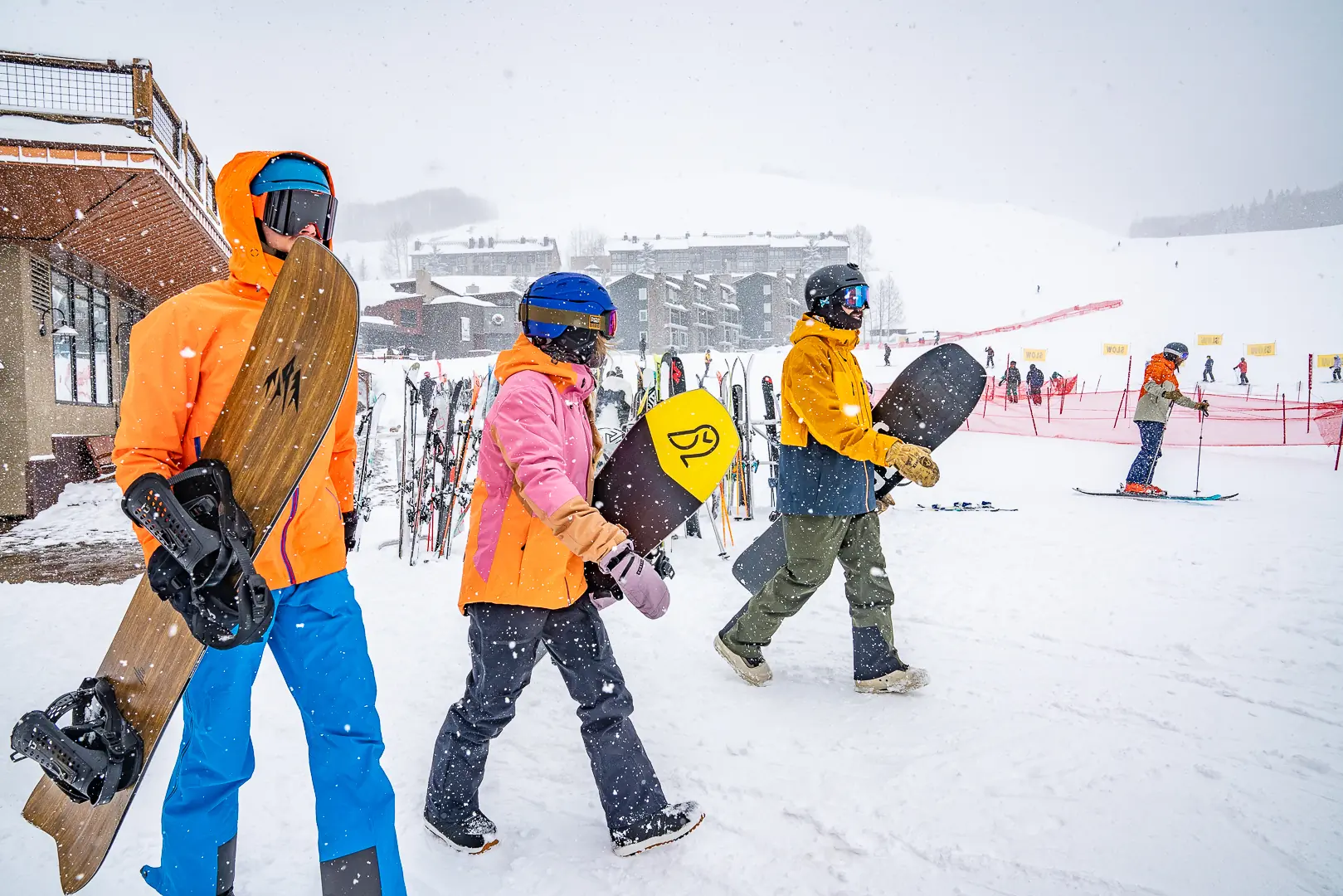



Flat
Flat boards are exactly what they sound like: flat. But without the camber and upturned edges, those can more easily catch. But a flat segment of a board does provide a loading zone for popping as well as a great surface connection for rails or other jibs.
Hybrid Rocker/Camber
Some riders prefer the stability of camber or flat with the playfulness of rocker. There are countless combinations of these two profiles across nearly every brand.
One hybrid, for instance, is to have rocker between the feet, camber underfoot, and rocker on the nose and tail — a mustache, if you will. Others have a dual combo of flat or camber underfoot followed by a healthy dose of rocker throughout the nose and tail (or vice versa). But some have a tiny bit of rocker toward the tip and tail.
These incremental differences give each board a unique personality on the mountain and plenty of options for riders.


Types of Snowboard Shapes
Directional Snowboards
With a directional design, the nose is a different shape than the tail and has unique attributes. Generally, this means the tail is more rigid, providing an anchor when cruising fast. And the nose more easily lifts through clouds of powder.
True Twin Snowboards
If you were to draw a line across the centermost width of the board and fold it in half, each side would be the same. This design has a symmetrical shape (including the nose and tail and sidecut radius), flex pattern, and profile. The stance is completely centered.
A twin setup is an ideal choice for riding switch, which lends itself to freestyle terrain or park tricks but can also be a very balanced feel for all-mountain terrain.




Directional Twin Snowboards
A directional twin is when there’s a slight variation on a twin design. So, the shape is nearly completely symmetrical with the same sidecut, flex, and profile for the nose and tail — except there’s a spin on an ingredient or two.
For instance, the profile could slightly differ between the nose and tail. The tail might have a stiffer core and flex compared to the nose. Possibly, the stance is setback rather than completely centered. Or, the nose could have a bit more rise for nice float.
Asymmetrical Snowboards
You know how the front of your body is proportionately different from its backside? An asymmetrical snowboard aims to help balance the human body, and it certainly feels different and fun to ride.
There are two ways asymmetry can be introduced in a board. A snowboard can have an asymmetrical sidecut, meaning the heel side is shorter and deeper. In contrast, the toe side is longer and shallower. This allows for easier, more balanced edge transfer between the toes and heels.
Some snowboard designs alter the core with softer materials beneath the heels along the backside of the board, compared to firmer materials along the toeside portion. Other designs blend both an asymmetrical sidecut and core.
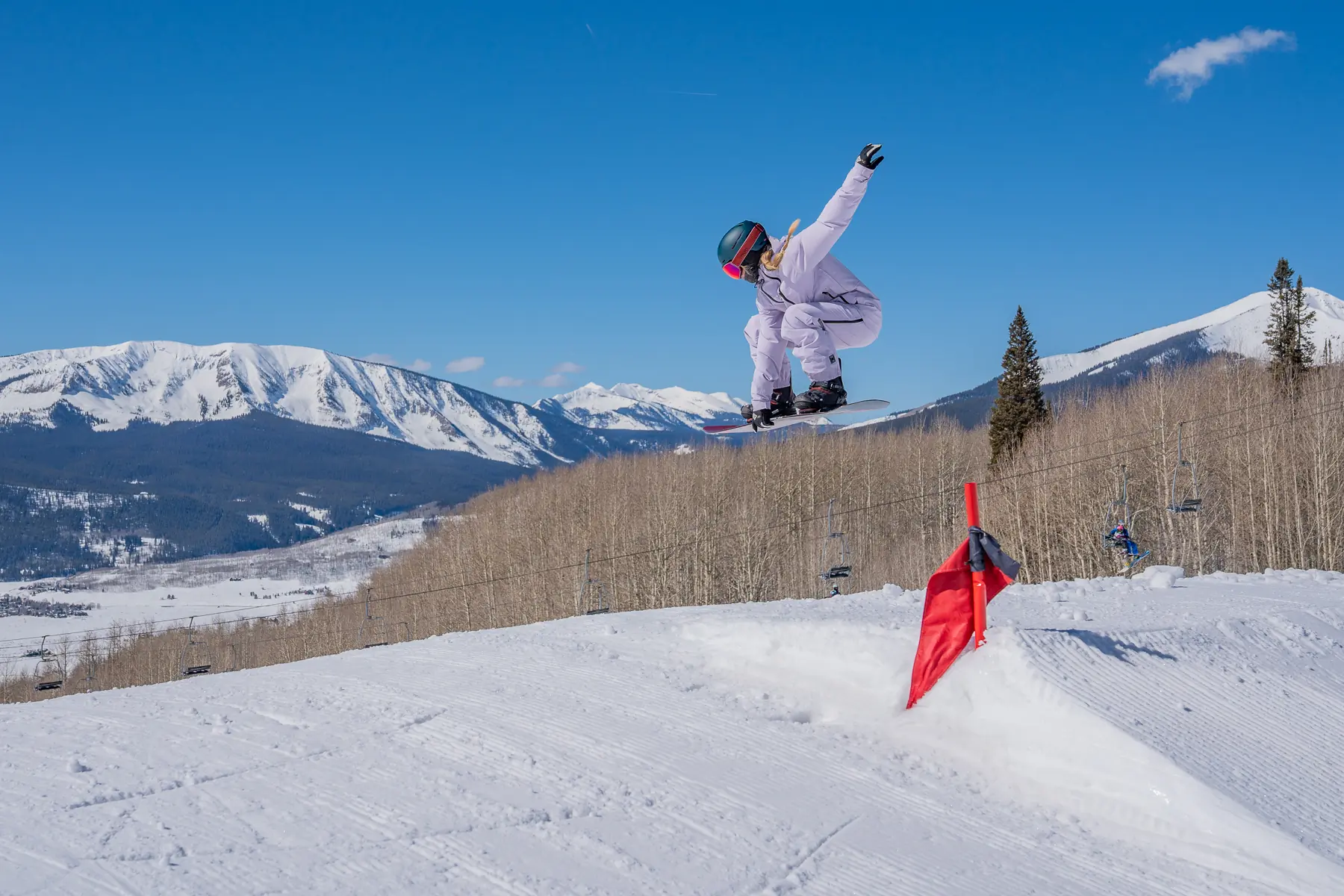



Asymmetrical Twin
This design combines asymmetrical design features with twin features. The nose and tail will have the same shape, profile, and flex. But the toeside and heelside sidecut will differ, or the flex of the core material will differ between the toe and heel edge, or both.
Core Construction & Materials
A snowboard’s construction and materials fundamentally affect its riding ability and performance. Everything from flex to pop is a result of the various components the board itself is made from.
Perhaps the most foundational part of every snowboard is the core. Most cores are made from strips of poplar, bamboo, birch, or aspen wood. These strips are laid out from tip to tail and are pressed into a structural length of flexible plywood.
Materials, including carbon and fiberglass, are added above and below the core to elevate or reduce characteristics such as pop, snap, flex, chatter, and dampness.
The price of every snowboard is a product of the quality of its materials. For example, carbon fiber is considered a premium material, and snowboards with carbon components are known for their stability, power, relatively low weight, and relatively high price tag.
On this list, all of the included snowboards are built from industry-leading, high-quality materials.


Snowboard Length
Though some riders believe in hard and fast rules for selecting the correct snowboard length, it’s ultimately a matter of personal preference. Board shape, rider height, rider weight, and riding style are all factors that should play into your decision about board length.
Most snowboards come in multiple lengths. Generally, longer boards offer a more aggressive ride and are preferred for hard, large-radius carves. If you’re the kind of rider who likes to absolutely bomb down groomers, we recommend a longer board.
On the other hand, shorter boards are often lighter, better for tight turns, and excellent for floating through powder.


Waist Width
Waist width is the width of a snowboard at its narrowest point. Width preferences vary from rider to rider, though there are a few general rules that are good to keep in mind as you choose a board.
Ideally, the waist width of your snowboard will allow your boots to just slightly hang over the edges of the board when placed in your bindings. When fitted properly, you’ll be able to use the minor overhang of your boots to apply leverage to the board and control your steering and speed.
If your board’s waist width is too narrow, your boots will overhang excessively, and your toes may scrape the snow while carving. To determine the ideal waist width for you and your foot side, always check out your board, boot, and binding manufacturers’ sizing charts before purchasing.




Flex & Dampness
The flexibility of a snowboard defines its riding experience. There are two primary kinds of snowboard flex. Longitudinal flex refers to how much the board bends along its length. Torsional flex refers to how much the board bends side to side across its width.
On this list, we’ve given every recommended snowboard a flex rating between 1 (soft and flexible) and 10 (stiff and rigid).
Snowboards on the soft and flexible end of the spectrum are generally geared toward beginners and freestyle riders. These boards require less force to turn and maneuver and are often described as playful. If you’re going to regularly press into butters, you’ll be glad to have a board you don’t have to fight against.
Stiff boards are better for hard-charging and aggressive carving at high speeds. When you’re riding fast, stiff boards will feel more stable as they’re less likely to vibrate and chatter.
Dampness is a positive trait that refers to a board’s ability to cruise at high speeds without sending uncomfortable vibrations into your feet and lower body. As a tradeoff, stiff boards require more work to turn and maneuver and thus should be avoided by beginners.
Many all-mountain snowboards fall somewhere in the middle of the flexibility spectrum. Not too soft and not too stiff is a good place to be for boards that aim to perform reasonably well on all kinds of terrain.




Boot & Binding Compatibility
Most snowboards are compatible with most snowboard boots and bindings, but there are a few key factors to consider when rounding out your setup. Your boots and bindings should match your riding style and the performance characteristics of your board.
In the same way that some snowboards are designed to thrive in powder, boots and bindings are each uniquely crafted to perform best in certain conditions. If your snowboard is a stiff and aggressive hard-charging monster, you don’t want a pair of soft and flexy boots that are made for the terrain park.
In other words, we recommend you match your board with boots and bindings with similar rigidity. When purchasing boots and bindings, be sure to select sizes that are compatible with the width of your board. You don’t want a binding base or a snowboard boot that hangs off the edge of your snowboard.
Furthermore, make sure that the attachment pattern for your bindings is compatible with your snowboard. Here are several general hole patterns:
- 4×4: two rows of holes that are 4cm apart plus each hole is 4cm apart and three holes per row
- 2×4: two rows of holes that are 2cm apart plus each hole is 2cm apart and six holes per row
- 3-hole: the holes are in a triangular pattern, and three screws are used to mount bindings
- Channel system: this is Burton’s specific mounting system where the bindings are mounted to and slide along a track




Effective Edge
This is the portion of the edge that connects with the snow while in a turn, which influences how a board feels. Typically, the effective edge is up to 35 cm shorter than the entire length of the board.
Sidewalls
The sidewall is the material along the edge of a snowboard. Generally, it’s a plastic that protects the sides of the sandwiched core layers. Or, the fiberglass and topsheet layer could be extended to conceal the edge. The sidewall could also be a hybrid construction.




Sidecut & Sidecut Radius
Each side of the board is curved along the edge. The depth and curvature of that sidecut influence the type of turn the board will make as well as how the ride feels. A shallower sidecut makes a wider turn, and a deeper sidecut creates a tighter turn.
To measure the depth of a sidecut, examine the width of the board at its centermost, narrowest point. Then compare that waist to the widest width measurement of the tip and tail.
To conceptualize the complete turn of a snowboard, you can visualize the sidecut extending to create a full 360-degree circle. The sidecut radius is half of that imaginary circle. When riding, each full turn is only as long as the sidecut radius, which usually ranges from 20 to 33 feet.


Snowboard Base
A snowboard’s base is the layer of material that makes contact with the snow as you ride. In order to get the best performance out of your board, it’s important to take good care of your base, repair it when necessary, and wax it regularly.
There are two kinds of snowboard bases. Each has its own pros and cons.
Extruded Base
Extruded bases tend to be found on entry-level and park-leaning snowboards. Made from melted polyurethane pellets, these bases are essentially one large piece of flat plastic. Because of this unified structure, extruded bases are durable and not very porous.
The main benefit of extruded bases is they require minimal maintenance. These bases are less likely to suffer gouges from riding over rocks or trees, and they usually only need to be waxed a few times per season.
Most extruded bases come pre-waxed when purchased new.




Sintered Base
Sintered bases are found on most midlevel to high-end snowboards. Unlike extruded bases, sintered bases are highly porous.
To keep sintered bases functioning at their best, frequent waxing is essential. Riders with sintered bases should be especially aware of thin spots and obstacles, as the porous material is relatively fragile and can be easily gouged or damaged.
Repairing a sintered base tends to be more expensive than repairing an extruded base. When properly maintained, sintered bases offer a faster ride — especially in wet, sticky snow.




Backcountry Snowboarding & Splitboarding
All of the snowboards on this list have been designed with in-bounds resort riding in mind. With that said, many of them would work in certain backcountry situations if you do not have a splitboard or your tour doesn’t require split-skis. For instance, if you plan to enter a sidecountry gate (aka slackcountry) at a ski resort, be dropped off at the top of a route via vehicle, if you can follow a bootpack up, or if you plan to snowshoe to a slope.
If you’re considering riding in the sidecountry or backcountry, it’s extremely important to be well-prepared. A beacon, shovel, and probe are non-negotiable gear, and an AIARE 1 avalanche safety training course is essential, too.
While strapping a snowboard to your back and hiking through the backcountry in snowshoes is a reasonable short-term plan, most backcountry riders will eventually want to transition to a more efficient splitboard.
Splitboards divide in half and can be used with skins just like backcountry skis. Once you’re ready to descend, the splitboard snaps back together and is ready to ride.
Though splitboarding can be a wonderful way to express your riding skills in the backcountry, the significant learning curve and financial investment required are barriers for many snowboarders.
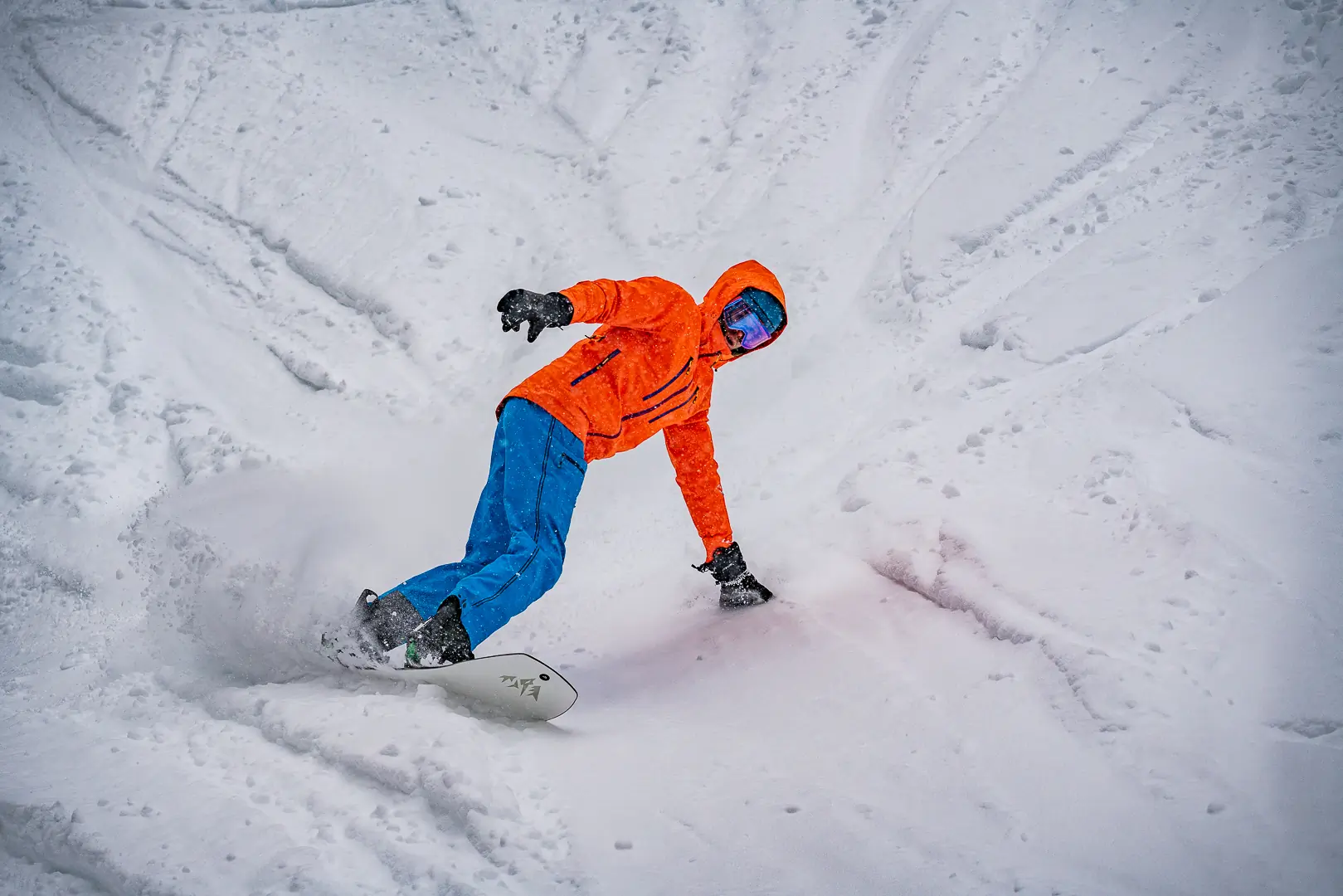



Eco-Friendly Design Features
Some snowboard designs incorporate sustainable, eco-friendly materials. For example, the Jones Women’s Flagship Snowboard incorporates recycled plastic for the sidewalls. And Lib Tech manufactures snowboards in the U.S.
A leader in the realm of sustainability is Arbor. For instance, the Swoon Rocker has recycled steel edges, sustainably harvested bamboo, and bioresin from waste products that replaces petroleum-based resin. At large, the brand sources materials from highly renewable, well-managed forests.
Arbor’s wood and bamboo cores and the majority of their top sheets are certified by the Forest Stewardship Council, a third-party nod that the materials are derived from responsibly managed forests. Its entire production line is solar-powered, too.




Price & Value
Budget
Snowboards that are more flexible and forgiving typically lack materials that drive up the cost. These boards can also be more squirrel-y on ice, in the steeps, and not offer as much rebound and power if you’re whipping at a top rate — so they’re more ideal for beginners and those who want to keep the shredding to mellower terrain or park riders that want a lot of spring. One example is the Burton Stylus Flat Top Snowboard ($400), and another softer option is the Never Summer Infinity Snowboard ($550).
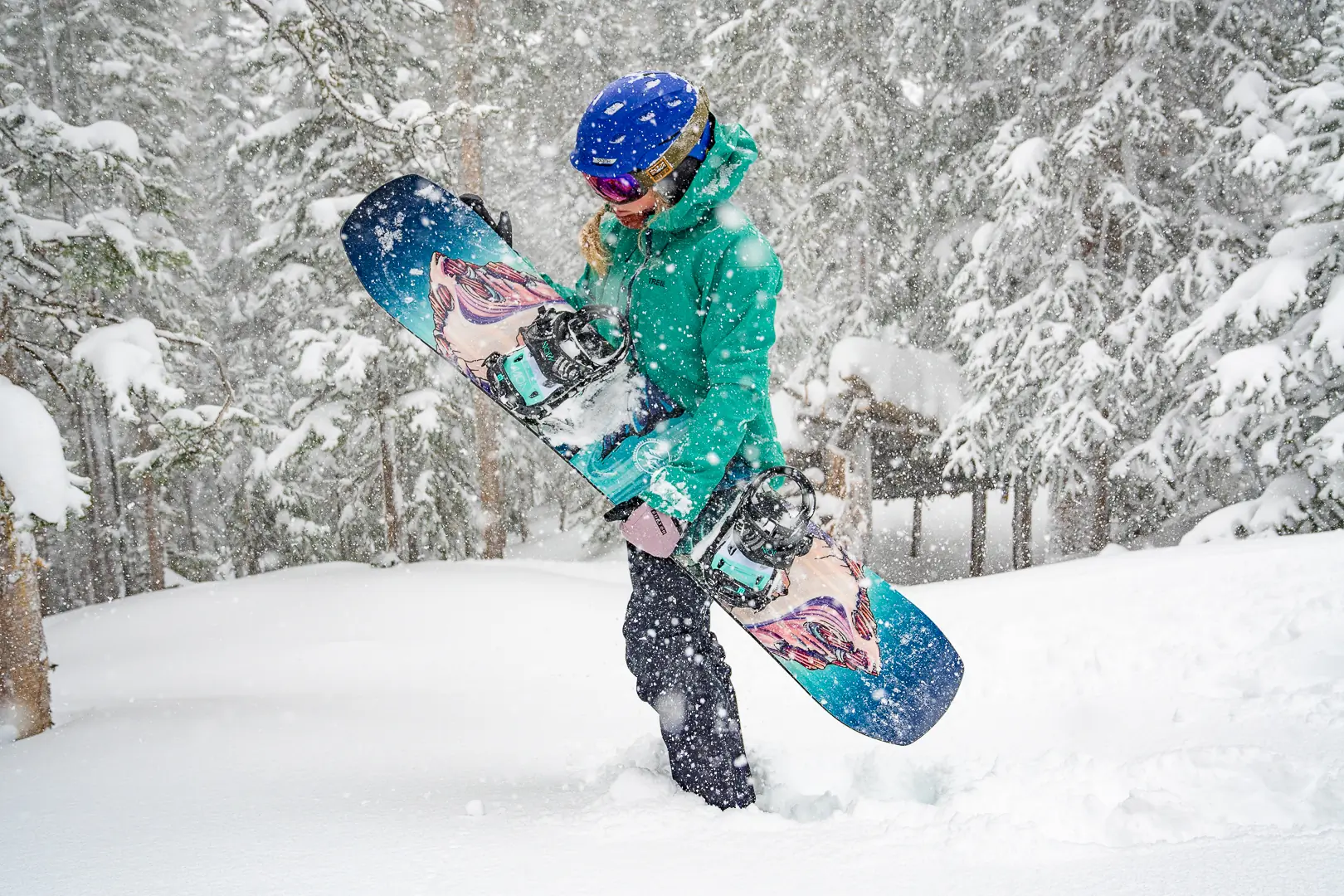



Mid-Tier
The majority of our picks are in the neighborhood of $600. You’ll typically find higher-end materials and more complex profiles and construction. A few examples include the Jones Stratos ($630), GNU Ladies Choice ($630), and the Stranda Descender Snowboard ($679). These boards usually offer a sweet spot of power and forgiveness while also being able to hold an edge, keep down chatter, and be maneuverable underfoot.
Premium
Reaching towards $700, you’ll find the WNDR Alpine The BelleAire ($699), Stranda Biru ($690), and Jones Flagship Snowboard ($700) — the most premium builds. These boards have even more complexity and unique materials like the algae-derived oils in the WNDR, while the Biru is a volume-shifted construction from a boutique brand that produces extremely durable and fun, surfy boards.


Frequently Asked Questions
An all-mountain snowboard is designed to ride in a wide variety of styles and conditions. While some snowboards are purpose-built for a certain kind of riding — such as park or powder — all-mountain snowboards can handle both and more!
On this list, we’ve selected the Burton Custom Flying V and the Lib Tech Cortado as our picks for the best all-mountain snowboards for beginners. Both of these snowboards are progression-oriented. They’re each relatively easy to control and maneuver, yet they offer high-quality construction and features that will support you as your riding improves.




When you choose a board, the brand will have a recommended size chart based on weight and boot size. You want to be sure to not have any boot drag off the side of the board!
You’ll also want to consider your height and the type of riding you want to do. Back in the day, folks would stand the snowboard next to themselves and if the board reached between the chin and nose, that indicated the correct size. You can get an idea of the snowboard size with that method, but be sure to consider your weight and boot size, too.
Generally, if you want to ride more aggressively and in steeper, faster, rugged conditions, a longer board can help drive more control, damping, and power. A shorter board will be snappier, quicker to steer, and easier to ollie. It’s often a good choice for riding through the park, tight glades, and moguls.
Ultimately, the best size comes down to personal preference, so try to demo or rent a few boards before buying your own.




No all-mountain setup is complete without a good set of boots and bindings. The boots and bindings you choose should be aligned with your riding style and ability.
Just like boards, boots and bindings exist on a spectrum from soft and flexible to stiff and aggressive. Softer boards generally pair well with softer boots and bindings. Similarly, stiff boots and bindings are commonly paired with a stiff board to create the ultimate aggressive and stable riding experience.
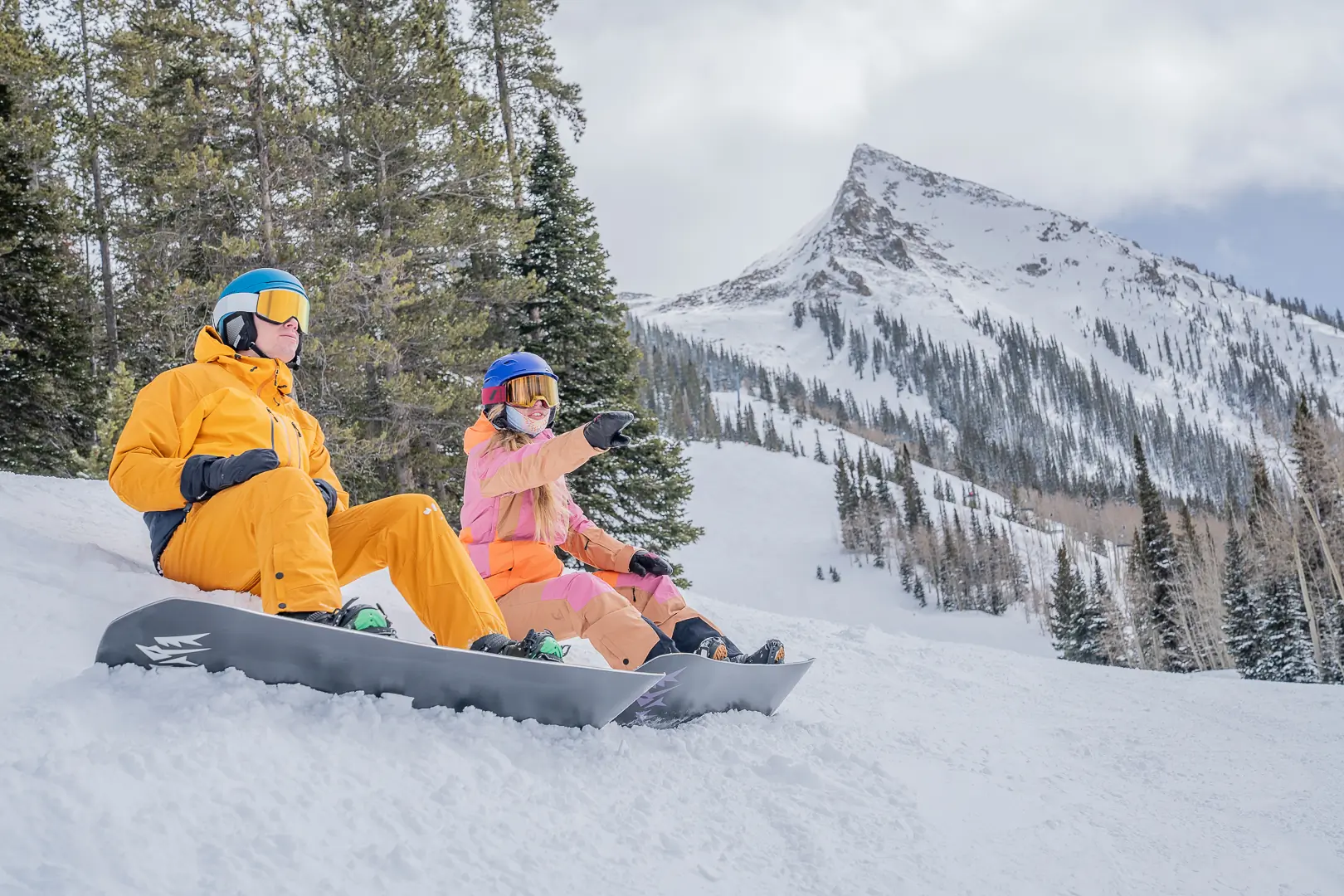



Often the biggest differences between men’s and women’s snowboards are sizing and shape. This includes the length, width, and sidecut ratio. Another big difference is the materials sandwiched in the core. Often, brands choose softer woods or laminates to better match the average woman’s stature.
Smaller men might find women’s boards compatible with their ride needs, and taller women also often opt for men’s boards. Ultimately, sizing is about choosing the right board for you and your shred style.
Would you drive your rig without an oil change? Snowboard maintenance is important! Make sure to wax your snowboard on the regular — every few times you ride — with wax that’s temperature-specific to your climate and conditions.
After finishing laps, it’s ideal to wipe down the snowboard, secure the bindings, and hang the board to store it. Make sure the edge stays deburred and sharpened with a whetstone and file.
If the base gets a gouge, you can fill and fix it with P-tex. For larger repairs or general maintenance, take your snowboard to a local shop for a base grind or a full tune.




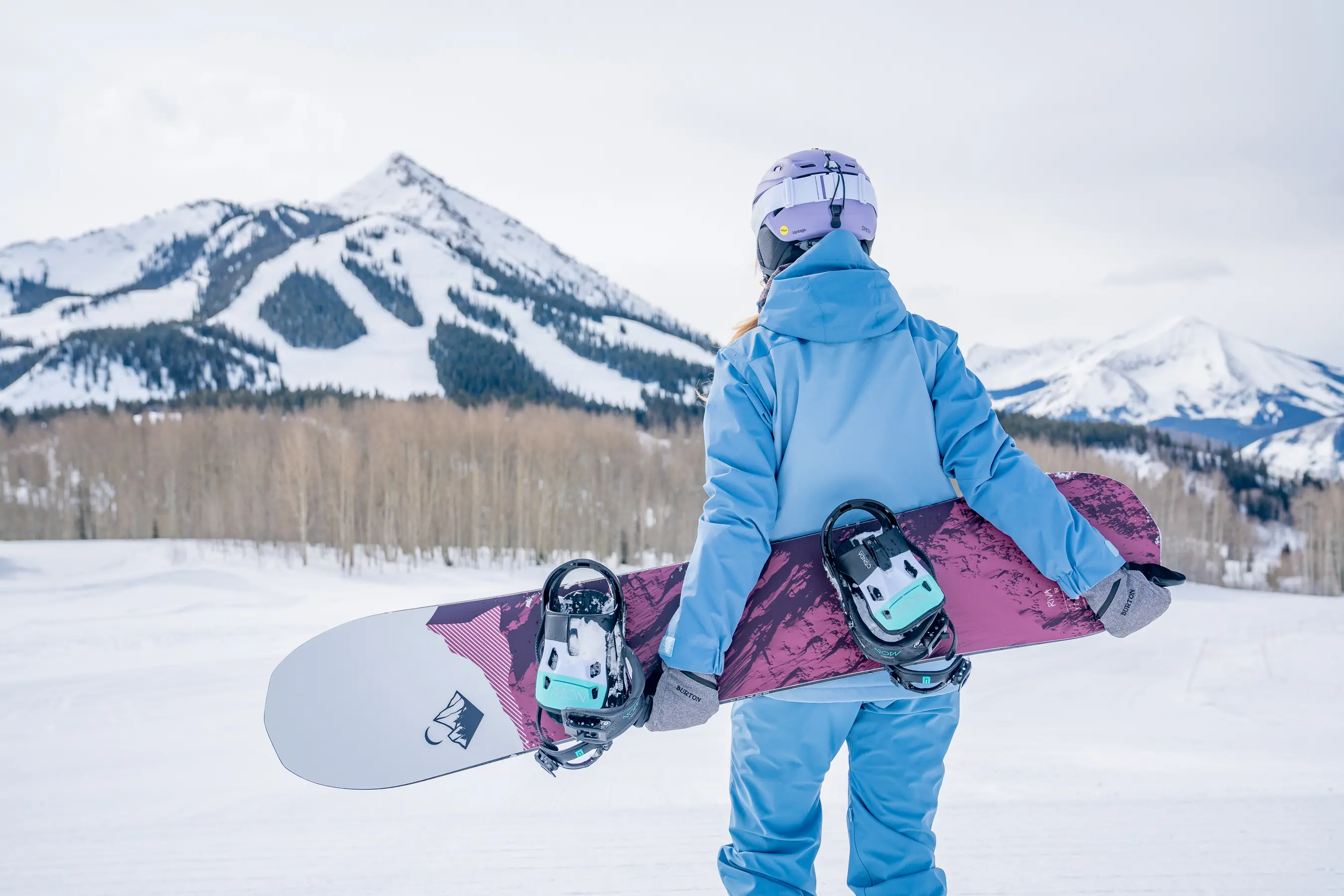

The Best Snowboard Bindings of 2025-2026
Solid, comfortable snowboard bindings are an essential part of connecting with the slopes. We tested the best sets including Rome, Union, and more.
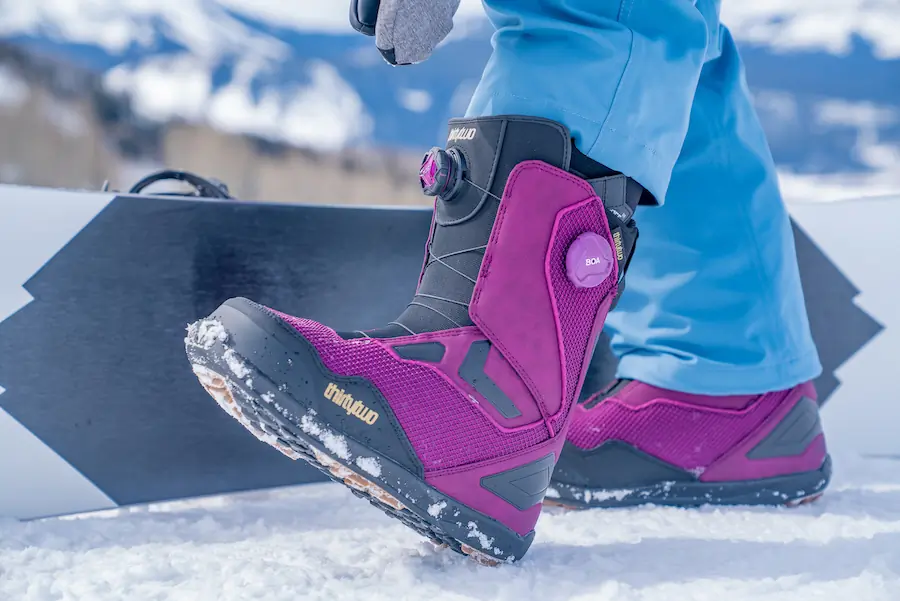

The Best Snowboard Boots of 2025-2026
We tested all-mountain and freestyle snowboard boots for the resort and backcountry to find the best options from Burton, Vans, K2, and more.


